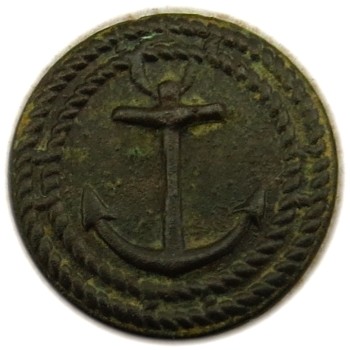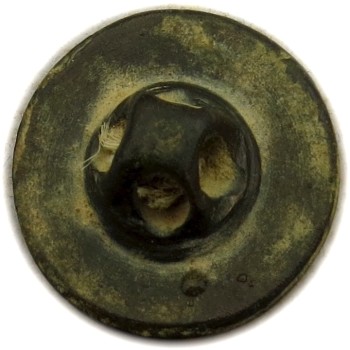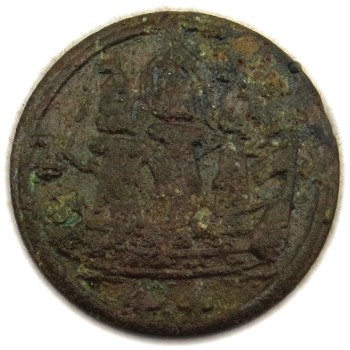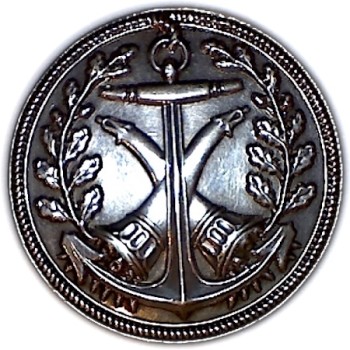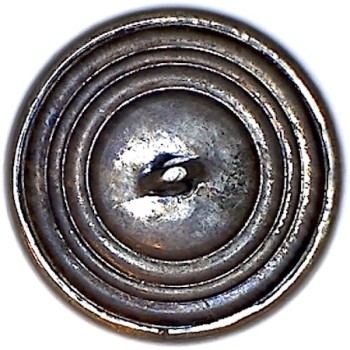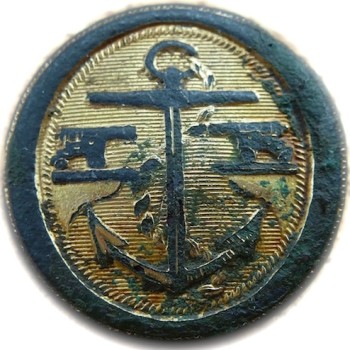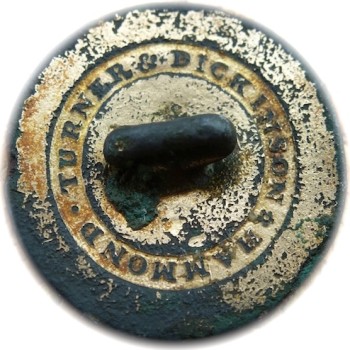* 1775 -1780’s Continental Navy *
American & French Design
********** ~ 1775 – 1815 ~ **********
********** * **********
The Continental Navy was first established in October of 1775. At the onset of the war, the Continental Congress didn’t establish any official guidelines or regulations for commissioned officers concerning their uniform style nevertheless the motifs of their buttons. Continental Navy officers were given a wide latitude of choice and furnished their uniforms using customary guidelines in place by other nations. They were given a latitude of discretion, and in most cases, the style choice was left up to their personal tailors who understood established military custom garments that were worn by other military-enabled countries such as the British, Dutch, or French.
As a collector’s note, in the 18th century, only commissioned officers of noted rank wore uniforms. Most undress uniforms only had silver or gilt plain flat or Tudor Rose buttons. As Captains and Lieutenants returned after long voyages to their home ports they would usually order new uniforms to follow any new regulation. Oftentimes times the regulation provided a wide latitude to detail as long as it followed the country’s prescribed motif. As far as uniforms and buttons for the seamen who made up crews, there was no official regulation for almost a century, and usually wore whatever they came aboard the ship wearing. Most times all they came aboard with was a duffle bag with clothes they thought would benefit them for seafaring journeys.
Buttons used by the Continental Navy Officers
********** * **********
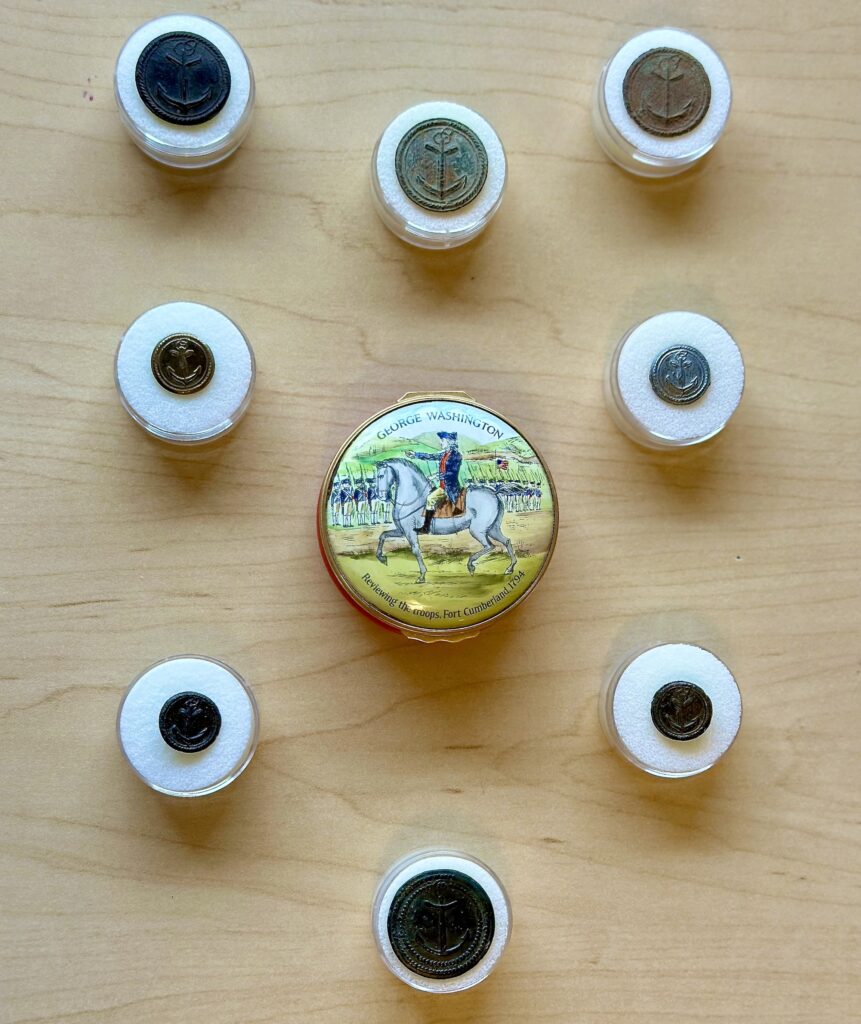
********** Rev War **********
********** ** **********
When the American Revolutionary War broke out in 1775, the Continental Commissioned Officers ordered their uniforms from their own personal tailors or local garment makers. Most times it was the tailor who provided the officers with the newest styles and kept their clients abreast with what is available within prescribed regulations or British Royal Navy or French Officers.
By September of 1776, the Congressional Marine Committee in Philadelphia established the first regulations for commissioned officers on their dress and undress uniforms which included for the first time prescribed button motifs. These new design regulation was vague and still allowed artisans to provide creativity in designs. An example of the regulation would call for blue uniforms that displayed flat yellow impressed buttons. This vague regulation allowed for a wide latitude for Commissioned Officers to wear a variety of designs that appealed to them.
Metal detector enthusiasts in America’s New England states seem to have dug a lot of French design motifs. One can reasonably say the Colonial Troops and Marines in Rhode Island were favorable toward French-designed buttons. These buttons usually depicted an anchor with a single or double cable circling around the legend. Navy button collectors should note that button manufacturing outside of crude design molds was pretty much non-existent in America. Continental Navy officers still fancied high-quality garment fabrics and motif buttons by the British and French garment industry. Collectors should also note it was commonplace for Continental Navy commissioned officers to use the same buttons on their dress as their undress uniforms as the war went on.
By 1779, there some money was appropriated by the Continental Congress for navy uniforms. We have records of French button manufacturer’s orders to supply both gilt, and plain white metal anchor buttons for their military dress uniforms. After a while French patterns were crudely copied by colonial artisan engravers in both Pewter and White Metal. To distinguish true American made buttons, one can look at telltale crude artisan designs such as the anchor’s curved or bowed stock, as well as a slightly barbed crown. There were even some colony button makers who tried to copy the French manufactures use of a bird cage-style shank. Collectors who find dug specimens within New England states should look to see if the reverse is a lathe-turned planchet. This is a 100% telltale clue to crude 18th century button-making in America.
The first official regulation of the Marine Committee in Philadelphia, on September 5, 1776 (Headed by John Hancock) prescribed for officers (Captains & Lieutenants uniforms): Blue Cloth.. flat yellow buttons…
Later in the Manuscript papers of John Paul Jones which is preserved in the Library of Congress, we find the following original paper, which is endorsed, “Uniform dress for the navy agreed to at Boston by the major party of the Captains, March 1777”
– Full Dress for Post Captains – Dark Blue Coats… yellow flat buttons, with the impression of the rattlesnake and motto, “Don’t Tread On Me” on each of them.
– Dress for Lieutenants – … instead of the rattlesnake, they wear buttons with the impression of an anchor.
*Albert’s NA 1 is an incorrect example of a Continental Navy Post Captain’s button, it shows a Georgia Chatham Artillery Button circa 1800’s. As of date, non of these Captain’s dress Rattlesnake Don’t Tread on me patterns have been recovered.~
********** Prologue **********
********** *** **********
When I began in the hobby of button collecting, everyone including Albert believed this “Rattlesnake button” NA 1 with an “impressed” insignia exists, but eluded Naval button collectors, and none are offered by the collector or metal detecting community as proof. Years earlier on my website, I mentioned to Navy collectors that the Chatham Artillery buttons of Savannah Georgia were mistaken as NA 1. This was simple enough for me because I easily put 2+2 together. The historical records said, “Congress regulation said, impressed, and these NA 1 buttons had a “raised motif.” So, here we are again many years later with a little better insight into history. Where do collectors turn to seek truth for NA1.
Robert’s Free Thinking: Rich merchants like John Hancock, and Jones Paul Jones were already established as noted wealthy ship Captains before accepting their commissions as Continental Navy Officers. These men were already part of, or tied to Freemason Revolutionaries through their own lodge associations, so naturally they adopted the, “Don’t Tread Upon Me,” motto and had Gilt “Impressed buttons” fashioned as sort of re-purposed Jacobite propaganda. These men would be able to afford talented colonial artisans make special order molds. These would be American-made possibly crude impressed buttons, not like the raised Royal Navy Anchor patterns produced in Birmingham England or France.
So, Captain Jones wears these specially made Revolutionary Rattlesnake symbol buttons on his uniform ( by this point) when he meets with the Second Continental Congress to help provide regulation frameworks for many things, including uniforms and buttons. Since these regulations are a secondary priority, the idea is mistakenly given or taken by committee members around him who are Freemasons themselves or look at him as a role model because of class stratification. So, at first the transgression of using a Snake symbol is not recognized as one of Jacobite. Most likely, because they are all Revolutionaries at heart, and see the symbol of Ben Franklin’s 8 segmented Snake or the rattlesnake being used by English-Jacobite propaganda media. The problem is the Rattlesnake symbol is geared with a Scottish Allusion attached. In this era, symbology carries multiple meanings which are Secrets, and made to be kept secret. Or since this was scene as a “Scots” war on both sides of the Atlantic and perceived this way in the media, one could look at it as forming alliance with the Scottish Gentry that controlled the American Shipping Trade –Chesapeake.
So, hence the problem, just as GWI 1-A has the wrong date. The wheels are in motion and breaks could not be put on quick enough. Up until this point, the symbol was only supposed to be used by Freemason Revolutionaries, not other officers of the Continental Navy or Army. So, someone must have put on the breaks for nationality associations to the Scots, and hence the Birth of the Anchor Motif was quickly adopted by the Continental Army. A decision was made to keep the Revolutionary propaganda insignia symbol separate and away from the Jacobite propaganda war. Specifically, not letting them use or understand the closely guarded secret of the true meaning of the rattlesnake symbol. This would be called “Operational Security.” Since no other military button will ever use the re-purposed Rattlesnake propaganda symbol until after the revolution, no one could be hung for treasonous behavior by the British or their loyalists! I believe there only four logical places where one of these Rare Navy-designed rattlesnake buttons would be found. Most likely a mold was made, and a number of Gilt Specimens were produced and dispersed in Savanah Georgia, South Carolina, Boston Massachusetts, and Rhode Island.
Robert’s Notes, in the Army we call it Operational Security or OPSEC, the key is to not divulge inadvertently to an enemy any part of your organizational structure or other information for them to exploit.– Lt. Co. R. Milburn
********** ********* **********
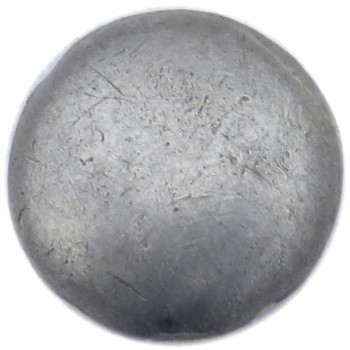
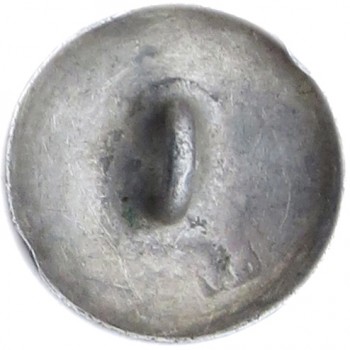
EARLY 18th CENTURY SILVER DOMED NAVAL OFFICER’S BUTTON
Color: Ghost Gray
Metal: Domed, 1-Piece, Plain Design, Solid Silver
Size: 17.97mm.
Rarity: R-2
Variety Type: Silver Plain Field Dome
Present Condition: A Non-Dug Specimen, Strong Planchet Condition, A Good Plain Field,
Obverse Button Analysis: This was a very popular silver cuff button among all sailing nations during the 18th Century. This could have been used by an officer serving in the military, merchant captains, or even sailors. This example appears to be manufactured in Great Britain by the English Manufacturing maker mark on the reverse.
Reverse Button Analysis: This is a one piece button with a loop shank. The shank is original, straight, and intact.
The RJ. Silverstein Collection.
Collector’s Note: The Continental Navy buttons usually distinguished themselves with a “Barbed Crown and “V” shaped Stock. This design pattern was kind of exclusive to the Continental Navy; but was not exclusive to only crown shape to be used by officers serving during the wartime effort. Prior to the RIR buttons of 1781, Rhode Island Regiments designated themselves with a pewter anchor design with a French-style rounded crown. This style was often used by Continental Navy officers as well. Tightly Dating these buttons which depict a French cable border design with a rounded crown would be difficult and most probably would cross over post-revolution by a good 10 years. The only thing for certain is early (Not exclusive) Continental Navy Officer’s buttons that were made in the colonies would have been originally pewter depicting a French cable/rope border design using a “Barbed Crown and V Shaped Stock”. Distinguishing the origins from molded American anchor buttons, the French manufacturers used a white or yellow metal in wartime production.
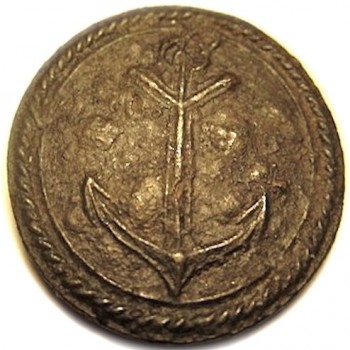
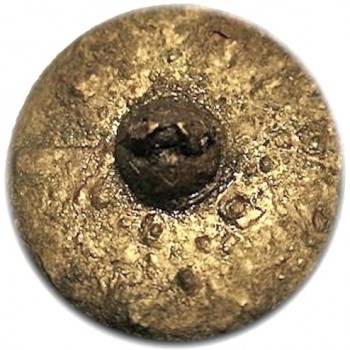
1775-90 CONTINENTAL NAVY OFFICER (Only Known Pewter)
Color: A Dark Pewter Grey.
Metal: 1-Piece, Slightly Convex, Raised Design, Cast Pewter.
Size: 24mm. Coat Size.
Troiani: ACNM.q. (Example Pictured in Book) Possibly American Made.
Variation: Upright Beveled Anchor / Barbed Crown / Thinner Stock / Wider Shaft / Single Decorative Cable.
Present Condition: An Excavated Specimen, Strong Planchet Condition, A Strong High Relief Pattern Remains.
Robert’s Comments: With a strong naval influence by the French Navy & Marines in Rhode Island, the American colonists who were serving in Rhode Island Regiments started copying and using a variation of the French Navy button design. This is the American Continental Navy Pewter Variation of a French Commissioned Navy officer’s button. American designs depicted a Barbed Crown with a “V” shaped Stock. The French design part would be the Rope or cable border instead of a pie crust or plain round border edge. The button’s pattern depicts an Upright Raised Beveled Anchor with a Pronounced Barbed Crown. This variation shows a Thinner Stock and Wider Shaft. Circling the anchor is a Raised Concentric Ring. Outside of the ring in the legend is a Single Decorative Cable. The high-relief pattern is set on a plain flat field with a thin flat edge.
Reverse Button Analysis: This is a one-piece button with a boss and a loop shank. The loop shank is original, but has decayed through on the top middle portion. The boss portion is still strong. The surface appears corroded and had a coarse bumpy texture.
The Dale Hawley Collection.~
This was Dug in Massachusetts.~
18th Century Design Conspiracy Notion: John Hancock’s shipping empire for traded goods was the underlying motivation for his personal Revolutionary Cause. No doubt he had a tremendous influence in the Continental Congress during the American Revolution. The notion of the “3 Roads of Prosperity” was a state of mind for the colonists and could possibly be portrayed within the anchor Shaft design of this button with a raised convergence point where the Crown, Stock, and Shaft rise-up to meet. There is no reason for this abstract design. Who is to say there isn’t a little bit of revolutionary sentiment in the truth of this peculiar design. Ha! R.J.S.
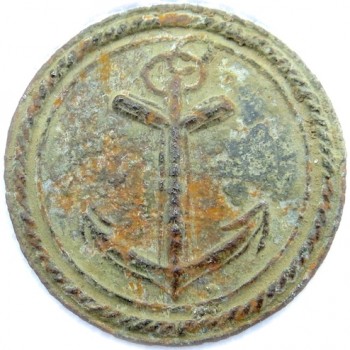
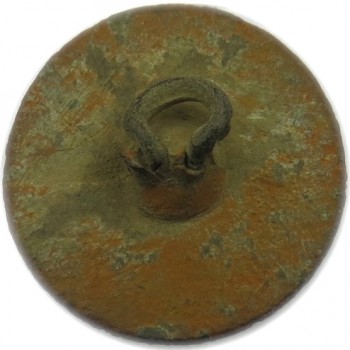
1775-90 CONTINENTAL NAVY OFFICER
Color: A Dusty Light Green.
Metal: Flat, 1-Piece, Raised Design, Yellow Metal.
Size: 24.53mm.
Troiani: Similar to ACNM.q. French Manufactured.
Variation: Upright Beveled Anchor with a barbed Crown / Larger Width Stock / Single Decorative Rope Edge Border.
Present Condition: An Excavated Specimen, Strong Planchet Condition, A Strong High Relief Pattern Remains.
Robert’s Comments: This button was most likely made in France. There is a die variant that is made in Pewter which is thought to be the American-made design copy. This button was most likely in use by Continental commissioned officers by 1780. The button’s pattern depicts an Upright Raised Beveled Anchor with a Pronounced Barbed Crown. The American pewter variation is very similar. The only noted differences was the anchor’s Width Size, and the “V” Angle of the Stock. Circling the anchor is a Raised Concentric Ring. Outside of the ring in the legend is a Single Decorative Cable. The high relief pattern is set on a plain flat field with a small flat edge.
Reverse Button Analysis: This is a one-piece button with a raised boss and a loop shank. The loop shank is original, and intact. Unfortunately bent over. The boss portion is still strong. The surface appears corrosive.
The RJ Silverstein Collection.
This was Dug by Ray Grenier in Upton, Massachusetts.~

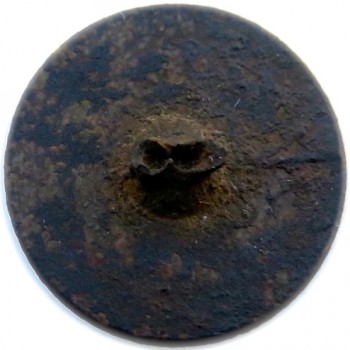
1775-90 CONTINENTAL NAVY OFFICER
Color: Black With Orange Patches.
Metal: Flat, 1-Piece, Raised Design, Yellow Metal.
Size: 24.04mm.
Troiani: Similar to ACNM.q. French Manufactured.
Variation: Upright Beveled Anchor with a barbed Crown / Larger Width Stock / Single Decorative Rope Edge Border.
Present Condition: An Excavated Specimen, Strong Planchet Condition, A Strong High Relief Pattern Remains.
Robert’s Comments: This button was most likely was made in France. There is a die variant that is made in Pewter which is thought to be the American-Made design copy. This button was most likely in use by Continental commissioned officers by 1780. The button’s pattern depicts an Upright Raised Beveled Anchor with a Pronounced Barbed Crown. The American pewter variation is very similar. The only noted differences was the anchor’s Width Size, and the “V” Angle of the Stock. Circling the anchor is a Raised Concentric Ring. Outside of the ring in the legend is a Single Decorative Cable. The high-relief pattern is set on a plain flat field with a small flat edge.
Reverse Button Analysis: This is a one-piece button with a raised boss and a loop shank. The loop shank is original, and intact. Unfortunately bent over. The boss portion is still strong. The surface appears corrosive.
The RJ Silverstein Collection.
Shane Lebanc Dug this in Bedford, Massachusetts 2012.~


1774-87 ROYAL NAVY CAPTAIN or CONTINENTAL NAVY OFFICER’S USE
Color: Earth Brown With Gilt Highlights.
Metal: Flat, 1-Piece, Impressed Design, Gilt Brass.
Size: 22.33mm Coat Size
Grams: 2.7g
Troiani: Cross Between to BNC.L. or BNC.M British Manufactured.
Variation: Fouled Anchor / V-Shaped Crown / Rounded Ends / Chain Coming off the Anchor’s Top Ring.
Present Condition: An Excavated Specimen, Good Planchet Casting, An Exceptional Impression Remains.
Robert’s Comments: This pattern was originally used for Royal Navy Captains & Commanders, but was adopted for American Officers serving in the Continental Navy. There was still commerce going on between the colonial colonies and English manufacturers, so it would have been normal for an American garment maker to order these buttons and use them on Continental Navy Officer’s uniforms. There are a number of variations to this pattern which depicts a chain link instead of a cable. It is similar to Troiani’s two book examples, but this specimen has attributes of both buttons. This button’s pattern depicts a Fouled Anchor with a V-Shaped Crown. There is a Chain Coming off the Anchor’s Top Ring on the left hand-side. The chain goes under a straight stock with Squared Ends, and then over and under the shaft. Then goes under the left fluke, and wraps under the pointed crown, and then goes up under the right fluke, and off the side of the button. The anchor’s stock has vertical lines in the shaft, crown, and flukes. The stock has horizontal lines. The crown and flukes have a Wide Pointed “V” Shape. The anchor pattern is stamped into a plain flat round brass planchet with no decorative or raised edge border.
Reverse Button Analysis: This is a One-Piece button with a loop shank. The shank is a little crushed but original, straight, and intact.
The RJ Silverstein Collection.
Dug at Shorwell on the Island of Wright.
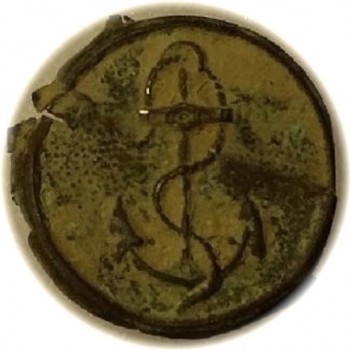
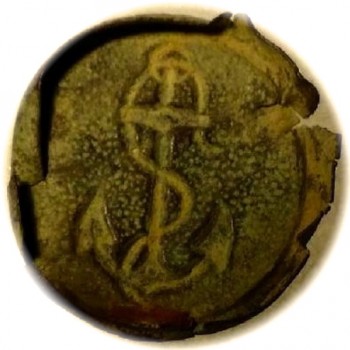
1775-90 CONTINENTAL NAVY OFFICER or ROYAL NAVY OFFICER’S BUTTON
Color: A Coppery Brown.
Metal: 2-Piece, Flat, High Relief Design Pattern, Gilded Copper Repousse.
Size: 25mm.
Albert”s: NA 4 (Similar too)
Troiani: Similar to ACNM.d. (Similar too)
Variation: High Relief Anchor with a Slightly Barbed Crown / Straight Stock / Raised Concentric Ring.
Present Condition: An Excavated Specimen, Good Planchet Condition, A Strong High Relief Pattern Remains.
Robert’s Comments: This button is a large 2-piece officer’s pattern. This appears to be sheet copper that was wrapped over a wood back. The button’s pattern depicts a High Relief Raised Anchor with a Slightly Barbed Crown. Circling the edge is a Raised Concentric Ring. In this particular die variant the Stock is Straight instead of slightly bowed. The rope goes under the right hand side of the stock and then goes upward through the Upright Top Ring and down under the left hand side of the stock. The rope the precedes downward and over and under the shaft. It rests over the left fluke where it dangles beneath the crown.
Reverse Button Analysis: This is a two-piece button with a wood or bone back. Most likely used cat gut cord for shank attachment.
Robert’s Notes: Collector’s should note the round design where the crown meets the stock. This depiction can be found on other Captain & Commander English Manufactured Royal Navy Buttons. Also the stipple field can be seen on other British Rev War Navy pieces. So, taken both pieces of information together we have our answer.
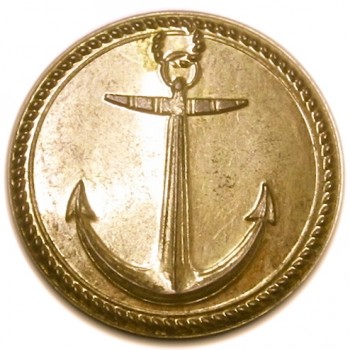
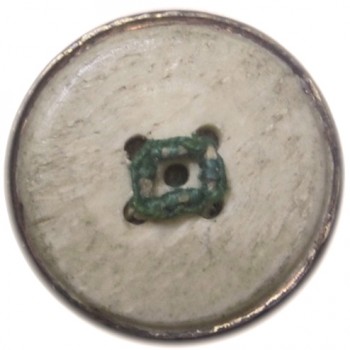
1780’s-1790’s FRENCH NAVY OFFICER or CONTINENTAL NAVY OFFICER
Color: An Antiqued Brass.
Metal: 2-Piece, Raised Design, Thin Sheet Brass or Gilt Copper Repousse.
Size: 26.20mm. Coat Size
Albert’s Number: Similar to RI 2-A (Albert’s Un-pictured)
Tice’s Number: RI009 AM1 French Manufactured.
Present Condition: A Non Excavated Specimen, Exceptional Planchet casting, Exceptional High Relief Pattern Remains.
Variation: Large Raised Beveled Anchor / The Stock is Straight / Cable Circling Around the Button’s Edge
Robert’s Comments: By comparing similar back bone specimens, the pattern can date as early as the mid 1770’s. If the buttons with this pattern was used by an American Navy Officers it probably was a transition button from the very end to post-Rev. War. The only thing I know for sure is that it is commissioned officers button of French Design. The three important identifying earmarks of this button is the Shape of the Crown, the Single Rope Border, and lastly the Bone Back Construction. The bone back gives us the evidence of it being an officer button, and most probably a sea coat button due to the large size. At this time only Commissioned officers in the Continental Navy wore dress uniforms. The pattern gives us a date of “around” the Revolutionary War. We do see very similar styles with double rope borders that were used by Continental Navy officers, and Rhode Island troops. Fallou’s book shows this style was officially adapted by both the American & French Naval Officers but does not mention a beginning use date, just mentions it was definitely in full use by 1790’s-1800. Tice notes in his book that this pattern was in use during colonial times in Rhode Island for the Train of Artillery in the County of Providence. He mentions the unit used this pattern when it went on to join the Continental Army in Boston. The button’s pattern depicts a Large Upright Beveled Anchor in the center. The Stock is Straight with Four Sets of Double Lines. The shaft is narrow at the stock and then gets increasingly wider toward the crown. Encircling the anchor is a thinly raised concentric ring. Just outside of the ring is a Thin Cable Circling around the button’s edge. The outside edge of the button is slightly beveled with a thin lip. The anchor’s Upright Top Ring has a looping rope connecting to the circling cable. The high relief pattern is set on a plain field with a lowered beveled edge.
Reverse Button Analysis: This is 2-Piece button with a Bone Back. This would have used cat gut cord for the attachment.
The RJ Silverstein Collection.~
Family Heirloom Provenance Rhode Island.
This button was purchased from Robert French a noted button dealer as a coat and cuff set from an old Rhode Island family who’s Great 3x Grandfather served in the Continental Navy. So this is an example of an American Officer choosing a French Manufactured button to where on his uniform. Usage date unclear.
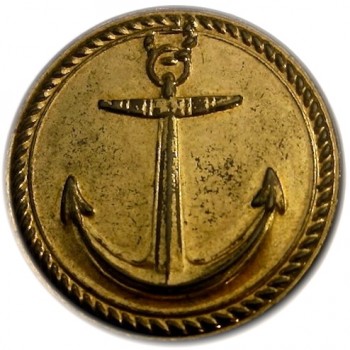
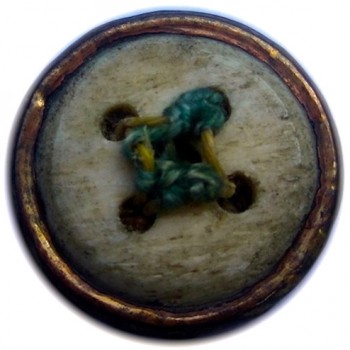
1780’s-1790’s FRENCH NAVY OFFICER or CONTINENTAL NAVY OFFICER (FRENCH DESIGN)
Color: A Marbled Spec Brass Yellow.
Metal: 2-Piece, Raised Design, Thin Sheet Brass or Gilt Copper Repousse.
Size: 18.25mm. Vest / Cuff Size
Albert’s Number: Similar to RI 2-Av
Tice’s Number: RI009 AM1 French Manufactured.
Present Condition: A Non Excavated Specimen, Exceptional Planchet casting, Exceptional High Relief Pattern Remains.
Variation: Large Raised Beveled Anchor / The Stock is Straight / Cable Circling Around the Button’s Edge
Robert’s Comments: By comparing similar back bone specimens, the pattern can date as early as the mid 1770’s. If the buttons with this pattern was used by an American Navy Officers it probably was a transition button from the very end to post-Rev. War. The only thing I know for sure is that it is an officers button of French Design. The three important identifying earmarks of this button is the Shape of the Round Crown, the Single Rope Border, and lastly the Bone Back Construction. The bone back gives us the evidence of it being an officer button, and most probably a sea coat button due to the large size. At this time only Commissioned officers in the Continental Navy wore dress uniforms. The pattern gives us a date of “around” the Revolutionary War. We do see very similar styles with double rope borders that were used by Continental Navy officers, and Rhode Island troops. Fallou’s book shows this style was officially adapted by both the American & French Naval Officers but does not mention a beginning use date, just mentions it was definitely in full use by 1790’s-1800. Tice notes in his book that this pattern was in use during colonial times in Rhode Island for the Train of Artillery in the County of Providence. He mentions the unit used this pattern when it went on to join the Continental Army in Boston. The button’s pattern depicts a Large Upright Raised Beveled Anchor in the center. The Stock is Straight with four sets of double lines. The shaft is narrow at the stock and then gets increasingly wider toward the crown. Encircling the anchor is a thinly raised concentric ring. Just outside of this ring is a Thin Cable Circling around the Button’s Edge. The outside edge of the button is slightly beveled with a thin lowered lip. The anchor’s Upright Top Ring has a looping rope connecting the circling cable. The high relief pattern is set on a plain field with a lowered beveled edge.
Reverse Button Analysis: This is 2-Piece button with a Bone Back. This would have used cat gut cord for the attachment.
The RJ Silverstein Collection.
Family Heirloom Provenance Rhode Island.
This button was purchased from Robert French a noted button dealer as a coat and cuff set from an old Rhode Island family who’s Great 3x Grandfather served in the Continental Navy. So this is an example of an American Officer choosing a French Manufactured button to where on his uniform. Usage date unclear.
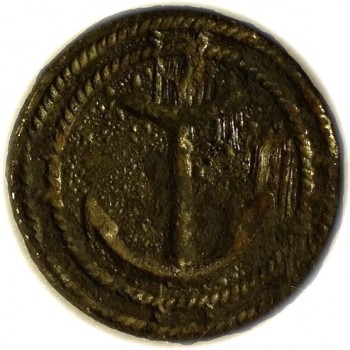
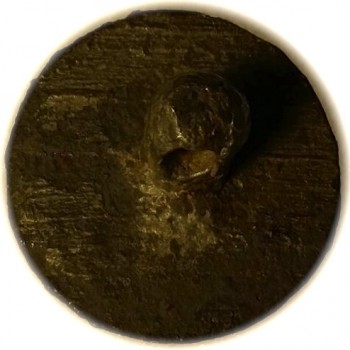
1776-83 CONTINENTAL NAVY OFFICER / RHODE ISLAND FRENCH COLONIAL TROOPS & MARINES
Color: A Pewter Silvery-Brown Mix.
Metal: Flat, 1-Piece, Impressed Design, Pewter.
Size: 24.5mm.
Troiani: ACNM.g (Specimen Pictured in Book) French Manufactured.
Variation: Raised Anchor / Round Crown / Double Rope Concentric Ring Border.
Present Condition: An Excavated Specimen, Strong Planchet Casting, A Strong Impression Remains.
Robert’s Comments: This is an American copy of a French Naval Officer’s button. This button has an impressed motif with an eye shank.The button’s pattern depicts an Raised Anchor with a Round Crown Style Crown. Circling the anchor is an Impressed Double Rope Concentric Ring Border. The inner rope border is looped through the Anchor’s UprightTop Ring. On the compass N, E, S, and W there is a Rope Bridge between the inner and outer rope borders. The high relief pattern is set on a plain flat field.
Reverse Button Analysis: This has a raised eye shank. The shank is original, straight, and intact.
1779-1780’s FRENCH MARINE OFFICER (RHODE ISLAND?)
Color: A Grayish-Silver Mix With green Encrustations.
Metal: Flat, 1-Piece, Impressed Design, Brass.
Size: 24.00mm. Coat Size.
Troiani: FCN.d. French Manufactured.
Variation: Raised Anchor / Slightly Barbed Crown / Single Ring Cable in Legend.
Present Condition: An Excavated Specimen, Strong Planchet Condition, A Strong High Relief Pattern Remains.
Robert’s Comments: This is a French Marine Coast Size button used during the Revolutionary War. The button depicts a Large Anchor with a Slightly Barbed Crown. The Anchor has a Bowed Stock and an Upright Top Ring. Circling in the legend is a Single Cable with double attachments at the commas points, N, E, S, and W. The high relief pattern is set on a plain flat field with a thin raised edge.
Reverse Button Analysis: This has a turret style shank. The shank is original, straight, and intact.
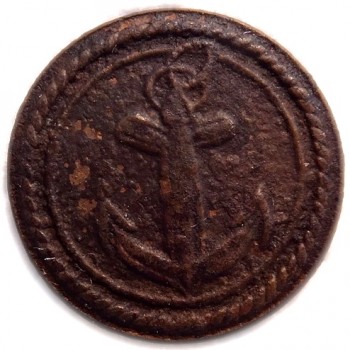
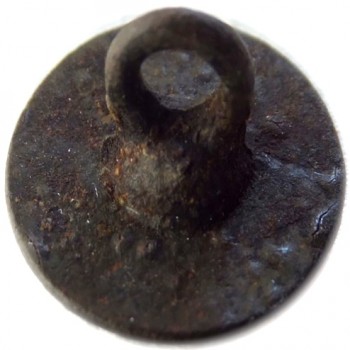
1778-83 CONTINENTAL NAVY OFFICER / FRENCH COLONIAL TROOPS & MARINES
Color: A Coppery Brown.
Metal: Flat, 1-Piece, Raised Design, Pewter.
Size: 16mm. Cufft Size
Albert’s: Unlisted Variant. American Made?
Variation: Upright Anchor / Barbed Crown / Raised Concentric Ring W/ Rope Border.
Present Condition: An Excavated Specimen, Strong Planchet Casting, A Strong High Relief Pattern Remains.
Robert’s Comments: Since this button was originally cast in Pewter it is hard to distinguish between this being an early elaborate Rhode Island / Marines or being geared for the Continental Navy. There is evidence and specimens that were made by British manufacturers as shown in the specimen below. All we can say is that this Pewter cuff button that was most likely used during the American Revolution. The British one followed in brass.
Reverse Button Analysis: This loops shank with raised boss. The shank is original and intact.
Dug by Curtis in a celar Hole in Warwick MA.
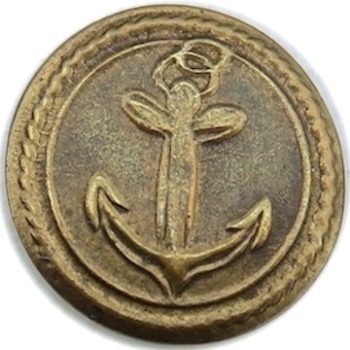

1778-80’s CONTINENTAL NAVY OFFICER / FRENCH COLONIAL TROOPS & MARINES
Color: A Brass Yellow.
Metal: Flat, 1-Piece, Raised Design, Brass.
Size: 15.88mm. Cufft Size
Albert’s: Unlisted Variant. British Manufactured.
Variation: Upright Anchor / Barbed Crown / Inside Raised Concentric Ring W/ Exterior Cable Border.
Present Condition: A Non Dug Specimen, An Exceptional Planchet Condition Remains, An Exceptional High Relief Pattern Remains.
Robert’s Comments: Continental Navy Design cuff button that was used possibly during and post Revolution. There are three size variants for the cuff. 15, 16, & 17mm. The original ones regardless of size are paper thin. This variant depicts an English spun back and raised boss. The later Anniversary British remakes appear to be penny size thickness.
Reverse Button Analysis: This English raised boss and has a loops shank. The shank is original and intact.
The RJ. Silverstein Collection


1778-83 RHODE ISLAND FRENCH COLONIAL TROOPS / MARINES or CONTINENTAL NAVY OFFICER
Color: A Coppery Brown.
Metal: Flat, 1-Piece, Raised Design, Cast Pewter.
Size: 15mm. Cufft Size
Albert’s: NA 2 Avl v2
Troiani: AVNM.k
Variation: Raised Fouled Anchor / Slightly Barbed Crown / Raised Concentric Ring Border.
Present Condition: An Excavated Specimen, Strong Planchet Condition, A Good High Relief Pattern Remains.
Robert’s Comments: This button has reportedly found in New York City and in the Hudson Highlands. The button depicts a Raised Fouled Anchor with a Raised Concentric Ring edge border. There is a rope coming off the Anchors Upright Top Ring on the left hand side. It goes under the stock, and then over and under the shaft 1 time. The rope ends dangling under the left fluke.
Reverse Button Analysis: This is a one piece cast button with a loop shank.

1774-87 CONTINENTAL NAVY OFFICER (British Design)
Color: A Coppery Brown.
Metal: Flat, 1-Piece, Raised Design, Gilt Brass.
Size: 15.35mm. cuff Size
Albert’s: Unlisted Variant. British Manufactured.
Variation: Raised Fouled Anchor / Barbed Crown / Impressed Ring Border.
Present Condition: An Excavated Specimen, Strong Planchet Condition, Strong High Relief Pattern Remains.
Robert’s Comments:
Reverse Button Analysis: This is a one piece cast button with a loop shank.
The RJ Silverstein Collection.
This pair of Cuff Links was Dug from a Rhode Island encampment.
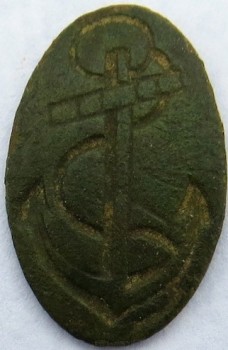
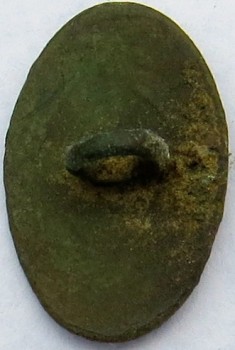
1770’s-80’s CONTINENTAL NAVY OFFICER’S CUFF (American Made)
Color: Emerald Green W/ Gilt Highlights.
Metal: Oval-Flat, 1-Piece, *Impressed Design, Gold-Wash Copper.
Size: 18.01 x 11.55mm. Cuff Size. Most Likely American Made
Variation: Fouled Anchor / Barbed Crown / Upright Top Ring / Slanted Lined Stock.
Present Condition: An Excavated Specimen, Strong Planchet Condition, A Strong Impression Remains.
Robert’s Comments: This appears to be American made with the usual colonial period Barbed Crown. This impressed pattern is usually associated with both the Colonial Seaman & Continental Navy officers gilt buttons. This is the kind of button that could have been easily used during the American Revolution by any Navy Officer or Captain. The button’s pattern depicts a Fouled Anchor with a Barbed Crown. There is a Slanted Stock with Four Decorative Lines. The cable comes off the anchor’s Upright Top Ring on the left hand-side. The cable goes then goes under the slanted stock and then under the shaft. The cable then goes under the left fluke, and then fish hooks toward the crown. The pattern is stamped into a plain flat oval brass planchet, and appears to have been gold-washed.
Reverse Button Analysis: This is a flat one-piece button with a loop shank. The shank is original, straight, and intact.
The RJ Silverstein Collection.
Dug in Massachusetts around the Bay in the 1970’s.
1780’s RHODE ISLAND COLONIAL TROOPS & MARINES (Enlisted Man’s Pattern / French Design)
Color: An Algae Green.
Metal: Flat, 1-Piece, Raised Design, Brass.
Size: 17.06mm. Cuff Size
Variation: Upright Anchor W/ Slightly Barbed Crown / Double Rope Border / Through the Anchor’s Top Ring
Present Condition: An Excavated Specimen, Strong Planchet Condition, A Strong High Relief Pattern Remains.
Robert’s Comments: These French design navy buttons were mostly worn by the French Marines or colonial naval troops. Americans stated producing there own variations using the French design sometime after the war started. Most American made buttons can be usually recognized by there version of the barbed crown, and the Bird Cage Style Shank. Most likely the original American made buttons were made out of pewter. By 1780, they would have had been made from some kind of white metal. These French design buttons usually have subtle differences, but essentially they were consistent with the anchor / double rope pattern. Some buttons might have more of a pronounced crown, but all American designed ones usually has a distinct barbed crown instead of the rounded crown. French commissioned navy officers usually had bone or wood backed Anchor patterns with a rounded crown. Also, some American made buttons had similar lottery style shanks. The button’s pattern depicts an Upright Pronounced Anchor with a Slightly Barbed Crown. Circling around the legend is a Double Rope / Cable. The inner circling rope is looped through the Anchor’s Upright Top Ring. The outer circling rope has a Rope Bridge at the N, E, S, and W compass points. The high relief pattern is set on a plain flat field with a thin raised edge.
Reverse Button Analysis: This is a Bird Cage style shank. The shank is original and intact.
Dug in Old Hampton by Bing Miller in the 1970’s.
Previously, the Bill Brown Collection.
The RJ Silverstein Collection.
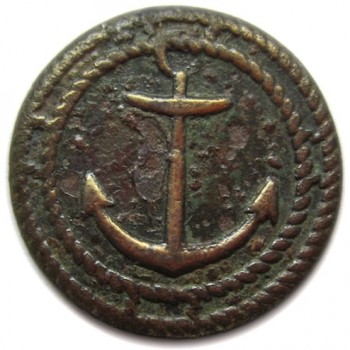
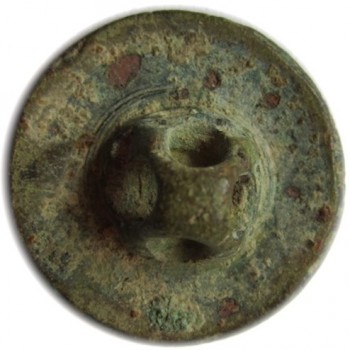
1780’s RHODE ISLAND COLONIAL TROOPS & MARINES (Enlisted Man’s Pattern / French Design)
Color: A Coppery Brown with Algae Green.
Metal: Flat, 1-Piece, Raised Design, Brass.
Size: 16.76mm. Cuff Size
Variation: Upright Anchor W/ Slightly Barbed Crown / Double Rope Border / Through the Anchor’s Top Ring
Present Condition: An Excavated Specimen, Strong Planchet Condition, A Strong High Relief Pattern Remains.
Robert’s Comments: These French design navy buttons were mostly worn by the French Marines or colonial naval troops. Americans stated producing there own variations using the French design sometime after the war started. Most American made buttons can be usually recognized by there version of the barbed crown, and the Bird Cage Style Shank. Most likely the original American made buttons were made out of pewter. By 1780, they would have had been made from some kind of white metal. These French design buttons usually have subtle differences, but essentially they were consistent with the anchor / double rope pattern. Some buttons might have more of a pronounced crown, but all American designed ones usually has a distinct barbed crown instead of the rounded crown. French commissioned navy officers usually had bone or wood backed Anchor patterns with a rounded crown. Also, some American made buttons had similar lottery style shanks. The button’s pattern depicts an Upright Pronounced Anchor with a Slightly Barbed Crown. Circling around the legend is a Double Rope / Cable. The inner circling rope is looped through the Anchor’s Upright Top Ring. The outer circling rope has a Rope Bridge at the N, E, S, and W compass points. The high relief pattern is set on a plain flat field with a thin raised edge.
Reverse Button Analysis: This is a Bird Cage style shank. The shank is original and intact.
The RJ Silverstein Collection.~
This was dug in Canada.~
Robert’s Notes: All French Colonial Troops wore blue coats while serving in America. Infantry units used white metal buttons, and Artillery units used yellow metal buttons, but all buttons were stamped with an Anchor.~
We know from the mid-18th Century forward, this anchor pattern has become the standard when identifying the French Colonial Troops & Marines of Rhode Island. At the time, this was the Ministere de la Marine – the Department of the Navy-. The troupes de la Marine was a separate little army that originated out of the French Metropolitan Army.


1780’s RHODE ISLAND COLONIAL TROOPS & MARINES or CONTINENTAL NAVY
Color: Dirty Brown W? Green Encrustations.
Metal: Flat, 1-Piece, Raised Design, White Metal.
Size: 16.61mm. Vest Size
Variation: Upright Anchor / Rounded Crown / Outer Fluid Rope & Inner Stipple Border / Stipple Loop Through the Anchor’s Top Ring.
Present Condition: An Excavated Specimen, Strong Planchet Condition, A Strong High Relief Pattern Remains.
Robert’s Comments: This buttons was most likely used toward the end of the Revolutionary War or just after by America’s small Navy. Equal Possibility of being used by the French with their shipping trade outside of Canada. The molded cuff button’s construction indicates it was most likely American made using a French Commissioned Officer’s design with the Rounded Crown. Loop shank with mold line. I know this pattern depicting a rounded crown was manufactured for French Officers in a Gilt Repousse which was wrapped over bone in the mid 1770’s. The only difference would be in the anchor’s stock. American made anchor buttons that usually depicted a bow “V” stock. The button’s pattern depicts a Large Upright Anchor with an Upright Top Ring. The anchor has a Rounded Crown and Small Flukes. The anchor’s Stock is Slightly Bowed as with all earlier American Rev War buttons. Circling around the legend is a Single Fluid Rope or Cable. The inner circle depicts a RARE Stipple Ring most likely to denote a cable / rope. 7 Stipples are looped through the Anchor’s Upright Top Ring. The high relief pattern is set on a plain flat field with a thin raised edge.
Reverse Button Analysis: A One-Piece button with a loop shank. The shank is original, straight, and intact.
The RJ Silverstein Collection.~
This was excavated in Rhode Island.
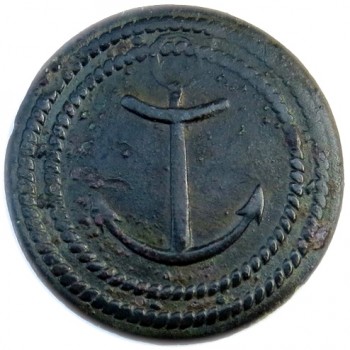

1780’s RHODE ISLAND MARINES or CONTINENTAL NAVY (AMERICAN MADE W/ FRENCH DESIGN REVERSE)
Color: Charcoal Black.
Metal: Flat, 1-Piece, Raised Design, White Metal.
Size: 27.66mm. Coat Size
Variation: Large Upright Anchor / Rounded Crown / Double Rope Border / Loop Through the Anchor’s Top Ring.
Present Condition: An Excavated Specimen, Strong Planchet Condition, A Strong High Relief Pattern Remains.
Robert’s Comments: This buttons most likely used toward the end of the Revolutionary War. The button was most likely American made using a French Commissioned Officer’s design with the Round Crown. Lottery style shank and lathe turned reverse probably means a colonial local. I know this pattern depicting a rounded crown was manufactured for French Officers in a Gilt Repousse which was wrapped over bone in the mid 1770’s. The only difference would be in the anchor’s stock. American made anchor buttons usually had bowed stocks. The French designs usually have stocks that are straight or bowed on the bottom. The button’s pattern depicts a Large Upright Anchor with an Upright Top Ring. The anchor has a Rounded Crown and Small Flukes. The anchor’s Stock is Bowed as with all earlier American Rev War buttons. Circling around the legend is a Double Rope or Cable. The inner circling rope is looped through the Anchor’s Upright Top Ring. The outer circling rope has a Rope Bridge at the E, and W at the compass points. North and south only display a Raised Stipple in-between the two cables. The high relief pattern is set on a plain flat field with a thin raised edge.
Reverse Button Analysis: This is a Bird Cage style shank. The shank is original and intact. This button is Lathe Turned in construction.
The RJ Silverstein Collection.~
This was excavated in Massachusetts.
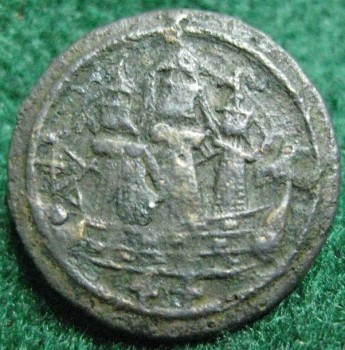
1767-1775 44th Regt. Royal Vaisseaux
1 of 3 Dug in Glouster Point, VA in 1970’s
1767-1775 THE FRENCH ROYAL-VAISSEAUX 44TH REGIMENT
Color: A Dark Green W/ Brown Undertones and Small Pockets of Orange Rust.
Metal: Flat, 1-Piece, Raised Design, Brass.
Size: 16.10mm. Cuff Size.
Variation: Sailing Ship / 44th Regiment Below.
Present Condition: An Excavated Specimen, Good Planchet Condition, A Fair High Relief Pattern Remains.
Robert’s Comments: The French Navy or Marine nationale, or informally La Royale, is the maritime arm of the French Armed Forces. It traces it’s roots back to 1624, and is recognized as one of the world’s oldest naval forces, and historically played a key part in establishing the French colonial empire on the American continent. Since the navy’s early foundings, its roles have been defined as maintaining intelligence, protecting populations, preventing crises, intervening wherever necessary to reestablish peace, and dissuading any threats against any vital French interests.
This button is one of the rarest French Navy buttons known to be dug in America from the Revolutionary War period. The number 44 has been found in both coat and cuff size buttons in Glouster Point, VA. We know this pattern has three different Regiment numbers, 44 , 33, and 26. We know that this button dates to Louis XV & XVI’s period, but uncertain if the regt. was detailed to a 64, 74, or 80 gun ship. The earliest of the regt. to use this pattern button was the 44th. Specimens using the number 44 have been dug in both coat and cuff sizes making it a jacket set. For reference, these 44 Regt. French Navy buttons (Royal-Vaisseaux) can be found on page 21 in Marian Hurley’s, “A Collector’s Guide to French Military Buttons of the American Revolution: 1775 to 1783.” We know the 44th regiment used this number from 1767 to 1775. Then the French Army went through a regiment reorganization in 1776, and the number 44 was ceased and interchanged with 26. Even though the 44th regiment was reorganized under the 26th, the 44 buttons continued to be used throughout the war by French troops serving in the southern colonies. The word, “Vaisseaux” means “Vessel” (as in a sailing ship), but most likely is a military reference as to say, “Ships of the Line.” For a drawing of this button bearing the 26th Regt. number, please look at “Military Buttons of the American Revolution.” Here you will see a Fallou sketch of the Royal Vaisseaux #26 button on page 155. The number 33 was also used with this pattern and overlaps in the same time frame of the mid-1770s to early 1780s. To see another example, please look at Hurley’s book on page 16, there you can find a set of Royal Vaisseaux #44 buttons that was dug near Yorktown, VA back in the early 1980s.
Reverse Button Analysis: This is a Bird Cage style shank. The shank is original and intact.
This was dug by Bing Miller in 1978, at Gloucester Point, VA.
Previously, the Bill Brown Collection.
The RJ. Silverstein Collection.
1767-1775 THE FRENCH ROYAL-VAISSEAUX 44TH REGIMENT
Color: A Dark Green W/ Brown Undertones and Small Pockets of Orange Rust.
Metal: Flat, 1-Piece, Raised Design, Brass.
Size: 16.10mm. Cuff Size.
Variation: Sailing Ship / 44th Regiment Below.
Present Condition: An Excavated Specimen, Good Planchet Condition, A Fair High Relief Pattern Remains.
Robert’s Comments: The French Navy or Marine nationale, or informally La Royale, is the maritime arm of the French Armed Forces. It traces it’s roots back to 1624, and is recognized as one of the world’s oldest naval forces, and historically played a key part in establishing the French colonial empire on the American continent. Since the navy’s early foundings, its roles have been defined as maintaining intelligence, protecting populations, preventing crises, intervening wherever necessary to reestablish peace, and dissuading any threats against any vital French interests.
This button is one of the rarest French Navy buttons known to be dug in America from the Revolutionary War period. The number 44 has been found in both coat and cuff size buttons in Glouster Point, VA. We know this pattern has three different Regiment numbers, 44 , 33, and 26. We know that this button dates to Louis XV & XVI’s period, but uncertain if the regt. was detailed to a 64, 74, or 80 gun ship. The earliest of the regt. to use this pattern button was the 44th. Specimens using the number 44 have been dug in both coat and cuff sizes making it a jacket set. For reference, these 44 Regt. French Navy buttons (Royal-Vaisseaux) can be found on page 21 in Marian Hurley’s, “A Collector’s Guide to French Military Buttons of the American Revolution: 1775 to 1783.” We know the 44th regiment used this number from 1767 to 1775. Then the French Army went through a regiment reorganization in 1776, and the number 44 was ceased and interchanged with 26. Even though the 44th regiment was reorganized under the 26th, the 44 buttons continued to be used throughout the war by French troops serving in the southern colonies. The word, “Vaisseaux” means “Vessel” (as in a sailing ship), but most likely is a military reference as to say, “Ships of the Line.” For a drawing of this button bearing the 26th Regt. number, please look at “Military Buttons of the American Revolution.” Here you will see a Fallou sketch of the Royal Vaisseaux #26 button on page 155. The number 33 was also used with this pattern and overlaps in the same time frame of the mid-1770s to early 1780s. To see another example, please look at Hurley’s book on page 16, there you can find a set of Royal Vaisseaux #44 buttons that was dug near Yorktown, VA back in the early 1980s.
Reverse Button Analysis: This is a Bird Cage style shank. The shank is crushed inwards.
This was dug at Gloucester Point, VA. just North of York River.
The Bill Brown Collection.
Robert, I have a large coat size Royal Vaisseau #44 that has quite a story behind it. It’s not pristine and is slightly bent and a tad flattened, but it still shows well. What’s so interesting is that it was dug on the right-wheel lane of an old abandoned colonial era road out in the middle of nowhere in Gloucester County, VA, just north of the York River. It was down about 5 inches, which isn’t much. I think that’s because dirt was always being pushed out of the way from when wagons would travel over it for more then 150 years. From what I could tell, the road was abandoned in the late 1800s, but you could tell the road was there, and it was lined by very old cedar trees and hardwood that formed a canopy over the road. I went back decades later, but the farmer had died, the was land sold, and then put under development. – Bill Brown.
Robert, Oh, failed to mention why it is slightly flat. I’m utterly convinced it got run over by any number of colonial wagons that used the road from the early 1700s thru the early 1800s, then the property just became a farmer’s side-road seldom used because a larger road was built; what is now the highway leading up to Gloucester Court House. – Bill Brown.
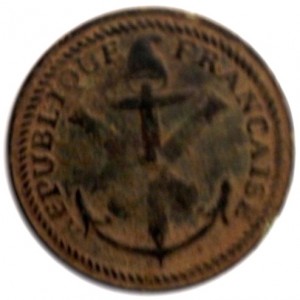
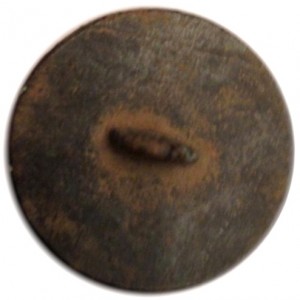
1795-1803 French Marine Artillery
Color: A Rusty Orange-Brown.
Metal: Flat, 1-Piece, Raised Design, Brass.
Size: 24mm. Coat Size
Variation: Cross Cannons / Liberty Night Cap
Present Condition: An Excavated Example, Good/Strong Planchet Condition, Strong High Relief Pattern Remains.
Robert’s Comments: This button was excavated as a coat and cuff pair in the low country of South Carolina by Estido Island in 2009. This is a real mystery on how it would have ended up there. This is one of my favorite French Republic Marine buttons. The button’s pattern depicts a large fouled anchor with a pointed barb and skinny flukes. There is a liberty night cap motif (Liberty Never Rests) rests on top of the anchor’s upright top ring. The anchor sits on top of the cross hatch of two crossed artillery cannons. Encompassing the anchor is France’s new salutation, “Republique Francaise”, which is written in capital letters. The outside edge border has a circling rope with a thin beveled edge. The high relief pattern is set on a plain flat field. This button’s pattern has wonderful symbolism for a fighting marine unit.
Reverse Button Analysis: This is flat one-piece button with a loop shank. The shank is original, straight, and intact.
Excavated By Bill Cross in South Carolina 2009.~
The Bill Cross Collection.
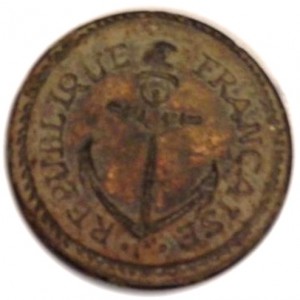

1795-1803 French Marine Artillery
Color: A Rusty Orange-Brown.
Metal: Flat, 1-Piece, Raised Design, Brass.
Size: 17mm. Cuff Size
Variation: Cross Cannons / Liberty Night Cap
Present Condition: An Excavated Example, Good/Strong Planchet Condition, Strong High Relief Pattern Remains.
Robert’s Comments: This button was excavated with the coat button illustrated above. This is a real mystery on how it would have ended up there. The button’s pattern is slightly different then the coat variant. It depicts a fouled anchor with a straight stock, and pointed barb on the crown. There is a liberty night cap that rests on top of the anchor’s upright top ring. Encompassing the anchor is France’s new salutation, “Republique Francaise”, which is written in all capital letters. The outside edge border has a circling rope with a thin exterior beveled edge. The high relief pattern is set on a plain flat field.
Reverse Button Analysis: This is flat one-piece button with a loop shank. The shank is intact, but crushed.
Dug By Bill Cross in South Carolina 2009.~
The Bill Cross Collection.
1804-1817 French Marine, Commissure de la Marine
Color: Silver.Metal: Flat, 1-Piece, Raised Design, Brass.
Size: 27mm. Coat Size
Variation: Cross Powder Horns
Present Condition: A Non Excavated Specimen, A Strong Planchet Condition Remains, An Exceptional High Relief Pattern Remains.
Robert’s Comments: Commissioned Officer’s button for French Naval Marines.
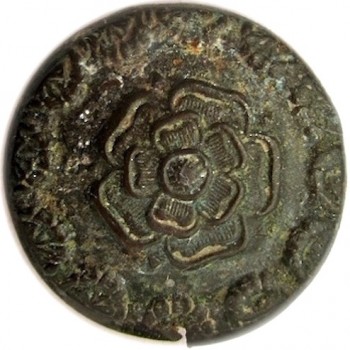
~ The Lieutenant’s Tudor Rose Button ~
~ 1748 to 1787 ~
The British Royal Navy was sailing around the world’s oceans for centuries before any kind of official regulation came into effect pertaining to regulation uniforms or buttons. The earliest records come from 1748 to 1767, when it was recorded officially that all Lieutenants wore flat gilded buttons with a recessed Tudor Rose on all their undress uniforms. The Tudor Rose was the English symbol for Royal Feuds. Some speculation exists that the Royal Navy Officers only used Tudor Rose Pattern buttons that depicted a double rose pattern. We know through historical records that after full dress was abolished in 1767, the Tudor Rose became the standard button on all Lieutenant’s uniforms until 1787-88. Prior to this they wore all plain domed buttons. Flag officers wore the Tudor Rose pattern on their undress uniforms from 1748-67, and then on all their uniforms up until 1795. Flag Officers (Various grades of Admirals) distinguished themselves by having a decorative wreath border around the Tudor Rose. Below is a sample listing of some variants found in the market. Tudor Rose Motif buttons can be found in many styles, and the different variations seems endless. Since this button’s pattern is still manufactured to this day, I would recommend early Royal Navy button collectors seek bone or wood back Repousse specimens to tightly date their collections. Also collectors should look for specimens in Gilt or all Silver for officer’s use. Regular pattern tudor rose buttons could have been used for general commercial or trade sailors.
The Table Below shows how the Tudor Rose Pattern was used:
Royal Navy Flag Officer 1748-67 Full Dress
Royal Navy Flag Officers 1767-95 All Uniforms
Each Royal Navy officer who reached flag-rank came from the Captains’ List. This seniority determined which officer was next in line for promotion; post-captains with greater seniority would be promoted before those officers lower down on the list. The Captains’ List was all-important:
Some research indicates that in 1757, All Captains wore Tudor Rose buttons on their Dress Uniforms. They were usually Gilt brass, or Solid Silver.~
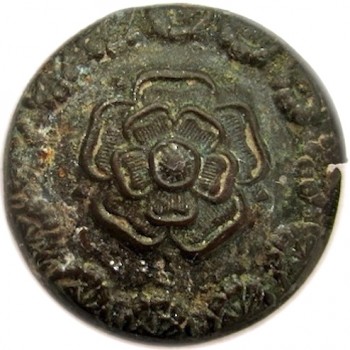
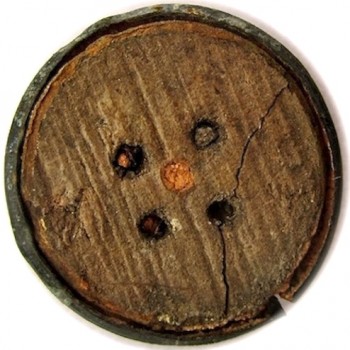
1748-95 ROYAL NAVY A FLAG OFFICER’S TUDOR ROSE BUTTON
Color: A Silvery-Olive Brown with Whitish Gold Encrustations.
Metal: Slightly Convex, 2-Piece, Raised Design, Gilt Sheet Copper Repousse.
Size: 25.11mm. Coat Size
Troiani: Similar to BNL.h. (This Specimen is Pictured in the Book)
Variation: Tudor Rose / Ornate Decorative Wreath Border.
Present Condition: An Excavated Example, Strong Repousse, Strong/Exceptional High Relief Pattern.
Robert’s Comments: We know from 1748 to 1767, all Lieutenants wore flat gilt buttons with a Tudor Rose on their undress uniforms. In 1767, full dress uniforms were no longer used, and the Tudor Rose buttons became the standard on all uniforms until November of 1787. In 1788, the Tudor Rose pattern was replaced for the new Anchor motif. From this point forward all Captains and Commanders would use this new Anchor style pattern. Some earlier dated Tudor Rose buttons are known to have used either bone or wood backs. These bigger buttons were probably used for their undress sea coats. This button’s pattern is a very rare example of a Tudor Rose with a Ornate Decorative Wreath Border. The high relief pattern is most likely stamped from reverse.
Reverse Button Analysis: This is a 2-piece button with a wood back and uses a cat gut cord for the attachment. The wood unfortunately has a mild crack, but otherwise is still intact.
The RJ Silverstein Collection.~
Excavated in the State of New York.~
Robert’s notes: A Flag Rank Officer is an honor bestowed on a senior Navy Captain who is assigned to lead a squadron of vessels in addition to the command of their own ship.~ The United States Congress did not create the title of “flag rank officer” as an actual rank in the Navy until 1857.~
XXXXXXXXXXXXXXXXXXXXXXXXXXX
The War of the Roses! Red Tudor Rose, White Tudor Rose of the Bonnie, The Black Tudor Rose of House of Hanover. These Tudor Rose buttons are found all over from Canada to inland UK. There is many styles and patterns. These should be viewed as people wearing fancy English/ Scottish patriot buttons to the English Houses. Sort of like wearing an American Flag pin.

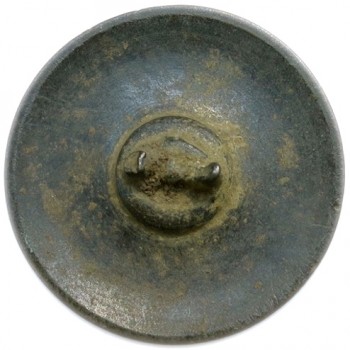
1748-1815 PROBABLY A COMMON BUTTON WORN BY ENGLISH LOYALIST
Color: A Charcoal Silver.
Metal: Flat, 1-Piece, Engraved Design, White Metal.
Size: 26.01mm. Sea Coat Size
Troiani: Similar to the BNL Series: Unlisted Variant.
Variation: Medium Size Tudor Rose / Large Field
Present Condition: An Excavated Example, Strong Planchet Casting, Strong Impression.
Robert’s Comments:
Reverse Button Analysis: This is flat button with a loop shank. The raised boss is still present, but the loop is missing.
The RJ Silverstein Collection.~
Dug by John on Prince Edwards Island, Canada.
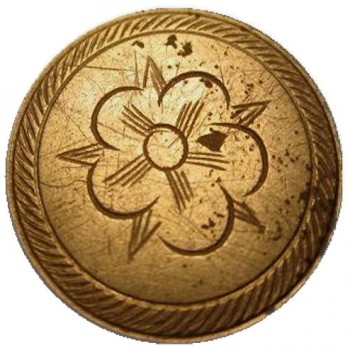

1748-1815 PROBABLY A COMMON BUTTON WORN BY ENGLISH LOYALIST
Color: A White Silver.
Metal: Flat, 1-Piece, Engraved design, White Tombac.
Size: 23mm. Coat Size
Troiani: Similar to the BNL Series: Unlisted Variant.
Variation: Medium Size Engraved Tudor Rose / Crude Style Cable
Present Condition: An Excavated Example, Strong Planchet Casting, Strong Engraving Pattern Remains.
Robert’s Comments: This is a completely different kind construction for a Tudor Rose Button. This button was made of White Tombac. White Tombac is an alloy of copper, zinc, and arsenic. Tombac was very popular with the colonist in America because the metal resembled silver, but was much more economically priced. What makes this button unique is it’s construction. The Tombac metal boss was poured and then they immediately inserted a wire loop while the metal set. The button’s reverse demonstrates the planchet was lathe turned. This method is much more time consuming and labor intensive then your common pewter poured mold specimens. The button’s pattern depicts a Medium Size Engraved Tudor Rose in the center. Circling around the outside edge is a Crude Style Decorative Cable. The pattern is engraved on a plain flat field with a small beveled edge border.
Reverse Button Analysis: This is a flat button with a loop shank. The loop is original, straight, and intact.
The Dale Collection.~
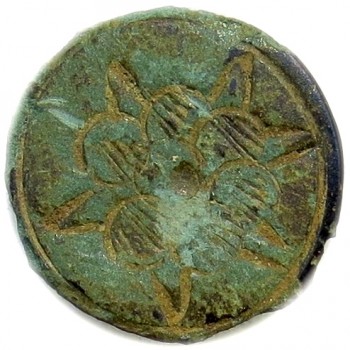

1748-1815 PROBABLY A COMMON BUTTON WORN BY ENGLISH LOYALIST
Color: A Sea Foam Green with Patches of Brown.
Metal: Flat, 1-Piece, Stamped Design, Gilt Brass.
Size: 16.05mm. Cuff Size
Troiani: Similar to the BNL Series:
Variation: Tudor Rose
Present Condition: An Excavated Specimen, Good Planchet Casting, Good Impression.
Robert’s Comments: The Tudor Rose was the English symbol for Royal Feuds. From 1748 to 1767, all Lieutenants wore flat gilt buttons with a recessed Tudor Rose on all their undress uniforms. This kind of Gilt Tudor Rose button would be one of your common buttons worn by Royal Navy officers. The button’s pattern depicts a Large Recessed Gilt Tudor Rose in the center, and an Incuse Gilt Ring circling the around the periphery. The stamped pattern is on a plain flat field. Collectors see a large number of these found in Canada waterways from the Royal Navy’s protection of trade.
Reverse Button Analysis: The button is a one piece button with a loop shank. The shank is intact, but partial side chunk is missing.
The RJ Silverstein Collection.~
Dug in Tracadie on Prince Edwards Island, Canada.~

1748-87 ROYAL NAVY CAPTAIN LIEUTENANT’S TUDOR ROSE DRESS CUFF
Color: A Golden Brown with Gilt Highlights.
Metal: Flat, Hexagon Shape, 1-Piece, Impressed Design, Gilt Brass.
Size: 15.93mm. Cuff Size
Troiani: Similar to the BNL Series: Unlisted Shape Variant.
Variation: Tudor Rose / Hexagonal Shape.
Present Condition: An Excavated Specimen, Exceptional Planchet Casting, Exceptional Engraved Pattern.
Robert’s Comments: This Tudor Rose Cuff button is a bit more detailed and lavish in it’s style of design then most common Gilt ones found. The pattern’s engraving shows exceptional work in the details. The Tudor Rose depicts a Checkered Center with Uniformly Lined Petals. The button also has an added Double Pattern Outlining the Tudor Rose. The button’s edge has the rarer Hexagonal Shape with a Slightly Beveled Edge. The engraved pattern is on a plain flat field. Hexagonal or Oval Shape cuff buttons are a bit more scarce then the commonly found round varieties.
Reverse Button Analysis: The button is a one piece button with a loop shank. The shank is original, straight, and intact.
The RJ Silverstein Collection.~
Excavated By J. Baldwin in a camp near St. Augustine, Florida.~
The Table Below illustrates how the Tudor Rose Pattern was used:
Royal Navy Lieutenant’s 1748-67 Full Dress to 1767.
Royal Navy Lieutenant’s 1767-87-88 All Uniforms.
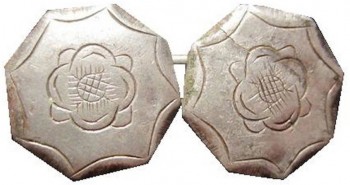
1757-74 ROYAL NAVY CAPTAIN OCTAGONAL DRESS CUFF
Color: A Flat Silver with A Touch of Green.
Metal: Slightly Convex, 1-Piece, Stamped Design, Thin Sheet Silver Silver Planchet.
Size: 15mm. Cuff Size (Also smaller examples in 12mm variant)
Troiani: Similar to the BNL Series: Unlisted Shape Variant.
Variation: Tudor Rose / Hexagonal Shape.
Present Condition: An Excavated Example, Strong Planchet Condition, An Exceptional Engraved Pattern.
Robert’s Comments: This is another die variant of a the popular Tudor Rose pattern used by officers of the Royal Navy. The button has the rare Hexagonal Shape desired by collectors. Between the crude depiction and the owner noting it is solid silver, it most likely was made by a jeweler or artisan familiar with engraving copper hardware. The button’s pattern has a very crude depiction of an English Tudor Rose engraved in the center. Within the center circle there is a Crude Cross-Hatch Depiction. Emanating out from the circle is a series of Uneven Lines using a N,S,E,W, Line Flow. Circling around the button’s edge is a Simple Decorative Line Border to match the Hexagonal Shape. The stamped pattern is on a slightly convex field. Hexagonal or oval shape cuff buttons are a bit more scarce then the commonly found round varieties.
Reverse Button Analysis: The button is slightly concave with a loop shank. The shank is original, straight, and intact.
The Dale Collection.~

~ The Royal Navy’s Captain & Commander’s Buttons ~
~ 1774 to 1787 ~
In the Colonial era, only commissioned officers wore uniforms. By 1748, they started to introduce specific pattern buttons for various commissioned ranks. Originally, the uniforms of Captains and Commanders were plain round gilt or silver domed buttons. This lasted until the new regulations of July 30, 1774. This new regulation required that all plain domed or round gilt buttons be replaced with flat buttons which depict a stamped anchor and cable or chain motif. This new regulation was very short lived, and was replaced in 1787, with a raised anchor pattern within a recessed oval frame.
Full dress frock coat of a Captain. The frock is of blue wool with button back lapels faced with white and edged with gold lace. Although it is possible to wear the coat with the lapels partially buttoned across the chest, there are also three hook and eye fastenings so that the coat can be closed without unbuttoning the lapels.
Robert’s Collector’s Note: Understanding the different patterns used is not the same thing as understanding the slight different variations of the pattern. The Royal navy commissioned officers had way of using the same pattern over various positions of Dress and undress over periods of time. Meaning, a button originally used for a Captain for a certain span of time would have changed for another commissioned position at a later date when the prescribed Captain’s button changed. So, the same button would have different use dates for various positions.
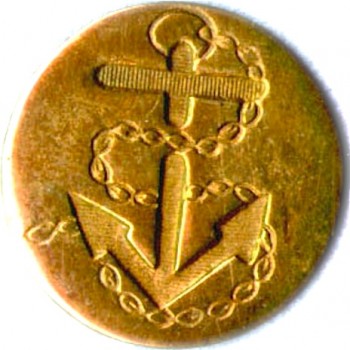
1774-87 ROYAL NAVY CAPTAIN’S BUTTON
1787-1805 Masters & Assistant Masters
1787-1807 RN Surgeons, Pursers, & Warrant Officers
Color: Brass Yellow with An Algae Green border.
Metal: Flat, 1-Piece, Impressed Design, Gilt Brass.
Size: 23.8mm Coat Size
Grains: 56.50
Troiani: Similar to BNC.l. or BNC.M
Variation: Fouled Anchor / V-Shaped Crown / Rounded Ends / Chain Coming off the Anchor’s Top Ring.
Present Condition: A Non Excavated Specimen, Exceptional Planchet Casting, Exceptional Impressions.
Robert’s Comments: This pattern was originally used for Captains & commanders, but was adopted for Masters, RN Surgeons, Pursers, Warrant Officers and even Mid-Shipmen in 1787-1807. This pattern was also adopted for American Officers serving in the Continental Navy. There was still commerce going on between the post-colonial states and English manufacturers, so it would have been normal for an American garment maker to order these buttons and use them on Continental Navy Officer’s uniforms. There are a number of variations to this pattern which depicts a chain link instead of a cable. It is similar to Troiani’s book example, but this exceptional specimen depicts a Rounded Stock for the Ends instead of square. This button’s pattern depicts a Fouled Anchor with a V-Shaped Crown. There is a Chain Coming off the Anchor’s Top Ring on the left hand-side. The chain goes under a straight stock with Rounded Ends, and then over and under the shaft. Then goes under the left fluke, and wraps under the pointed crown, and then goes up under the right fluke, and off the side of the button. The anchor’s stock has vertical lines and the shaft, crown, and flukes have horizontal lines. The crown and flukes have a Wide Pointed “V” Shape. The anchor pattern is stamped into a plain flat round brass planchet with no decorative or raised edge border.
Reverse Button Analysis: A One Piece button with a loop shank. The shank is original, straight, and intact.
Cobb believed this button belonged to an officer in the Connecticut Navy who served during the American Revolution. It was discovered in January, 1961 on a pair of white naval breeches that had been owned by Burdette G. Johnson of St. Louis, Missouri. Johnson had bought the breeches in Philadelphia years earlier. On the breeches were 12 small size Eagle and Star buttons GWI 12-B, and three naval buttons. Eleven of the 12 Eagle & Star buttons were sold to various collectors. One of the three naval buttons was sold to Sally Luscomb, and this one went to Cobb. The breeches, with one Eagle & Star and the one Naval Officer’s Fouled Anchor button ( still attached), were sold to DeWitt, who exhibited them in his museum in Hartford, Connecticut.~
Jose C. Collection.
Stacks Auctions January 2003.~
Harold Cobb/Descendants 1958 to 2003.~
Cobb Purchased this from J.J. Goldberg (B.G. Johnson) in 1961.~


1774-87 ROYAL NAVY CAPTAIN’S BUTTON
1787-1805 Masters & Assistant Masters
1787-1807 RN Surgeons, Pursers, & Warrant Officers
Color: An Ochre of Brown, Greens and Golds.
Metal: Flat, 1-Piece, Impressed Design, Gilt Brass.
Size: 16mm, Coat Size
Troiani: BNC.l.
Variation: Fouled Anchor / Barbed Crown /Square Ends / Chain Coming off the Anchor’s Top Ring.
Present Condition: An Excavated Example, Exceptional Planchet Casting, Exceptional Impressions.
Robert’s Comments: This pattern was originally used for Captains & Commanders, but was adopted for Masters, RN Surgeons, Pursers, Warrant Officers and even Mid-Shipmen in 1787-1807. There was still commerce between the post-colonial states garment makers who operated in America, so it would have been normal for them to order these buttons and place them on Continental Navy Officer’s uniforms. There are a number of variations to this pattern which depicts a chain link instead of a cable. This button’s pattern depicts a Fouled Anchor with a Barbed Crown. There is a Chain Coming off the Anchor’s Top Ring on the left hand-side. The chain goes under a Straight Stock with Square Ends, and then looped under the shaft 2x. Then goes under the left fluke, and wraps under the barbed crown, and then goes up under the right fluke, and off the side of the button. The anchor’s stock has Evenly Spaced Vertical Lines and the shaft and crown have evenly spaced horizontal lines. The button depicts a Wide Bowed Barbed Crown & Flukes. The pattern is stamped into a plain flat round brass planchet with no decorative or raised edge border.
Reverse Button Analysis: This is a one-piece button with a loop shank. The shank is original, straight, and intact.
The Heavy Metal Nut The Dave Wise Collection.
The table below shows how a specific pattern was used over time by different ranks of Naval Officers:
Capt./Commander 1774 to 1787
RN Master & Mate 1787 to 1807
RN Surgeon 1787 to 1805
RN Purser 1787 to 1807
RN Warrant Officer 1787 to 1860
RN Midshipman 1787 to 1812
RN Volunteer Gr.I 1787 to 1812
*RN is the designation for Royal Navy.~

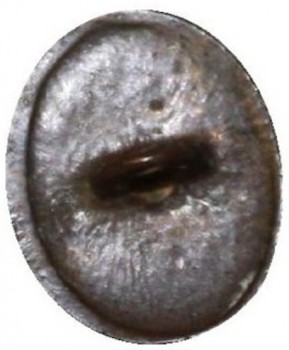
1776-87 CONTINENTAL NAVY OFFICER OR CAPTAIN’S BUTTON
1774-87 ROYAL NAVY CAPTAIN AND COMMANDERS OVAL CUFF BUTTON
Color: Brown Bess.
Metal: Oval, Flat, 1-Piece, Stamped Design, Brass.
Size: 14.58mm x 11.58mm. (Oval) Cuff Size
Troiani: Similar to BNC.q. Unlisted Variant Shape
Variation: Large Fouled Anchor / Chain off the Anchor’s Top Upright Ring / “V” Stock / Uneven Lines.
Present Condition: A Non Excavated Specimen, Strong Planchet Casting, Strong Impressions.
Robert’s Comments: I believe this button was the American artisan’s version to the popular style that was commonly used by Royal Navy Officers. Unlike the high quality english buttons counterparts of this same motif, this button shows too many irregular cuts and uneven lines throughout the anchor. I cannot rule out that some Royal Navy Captains and Officers did not use this button, but personal protocol for uniformity and a-semblance to this crude depiction would reason otherwise. There was some undocumented research on-line that said this unique pattern was used by U.S. Navy Seaman after the Rev War, but that is neither here nor there. This button’s pattern depicts a Large Fouled Anchor stamped in the Center. There is a Chain Coming off the Anchor’s Upright Ring on the left hand-side. The chain goes under the whole Curved or Bowed Stock with Rounded Ends. The chain then goes behind the shaft 2x, and then falls behind and below the left fluke. The anchor has a Narrow “V” Shaped Crown with Uneven and Irregular Lines. The shaft and stock also has irregular and uneven lines. The pattern is impressed into a plain flat oval brass planchet with no decorative or raised edge border.
Reverse Button Analysis: This is a one-piece button with a loop shank. The shank is original, straight, and intact. No back mark.
The RJ Silverstein Collection.~
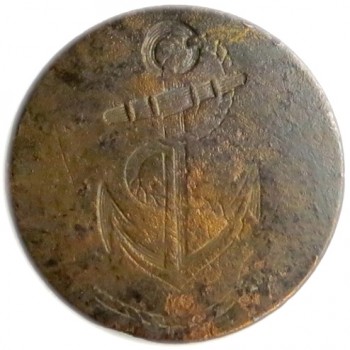
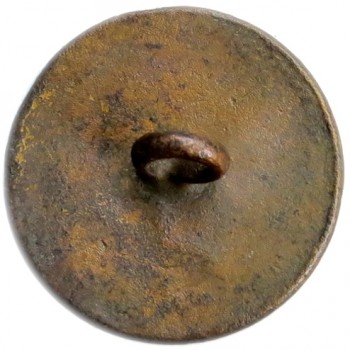
1776-87 CONTINENTAL NAVY OFFICER OR CAPTAIN’S BUTTON
1774-87 ROYAL NAVY OFFICER OR CAPTAIN’S BUTTON
Color: A Golden Brown with Charcoal Spotted Areas.
Metal: Flat, 1-Piece, Impressed Design, Brass.
Size: 24.25mm. Coat Size
Variation: Fouled Anchor with Decorative Lines and A Barbed Crown / Lined Upright Top Ring / Slanted Stock.
Present Condition: An Excavated Specimen, Strong Planchet Casting, Strong Impressions.
Robert’s Comments: Because of the Barbed Crown, this pattern is associated with both the Continental Navy and earlier Royal Navy officers. This is the kind of button that could have been easily used during the American Revolution by any Continental Navy Officer. The button’s pattern depicts a Fouled Anchor with Decorative Lines and a Barbed Crown. The cable comes off the anchor’s Upright Lined Top Ring on the left hand-side. The cable goes under a Slanted Stock with Four Raised Lines, then over and under a partially lined shaft. The cable then goes under the left fluke, and then fish hooks below the crown pointing toward the right hand side. The crown and flukes depict a Slender Barbed Crown with Narrow Pointed Flukes. The pattern is stamped into a plain flat round brass planchet, and has no decorative or raised edge border.
Reverse Button Analysis: This is a flat one-piece button with a Copper loop shank. The shank is original, straight, and intact.
The RJ Silverstein Collection.~
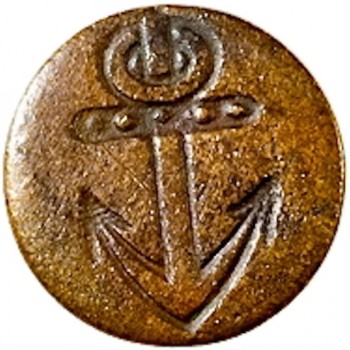
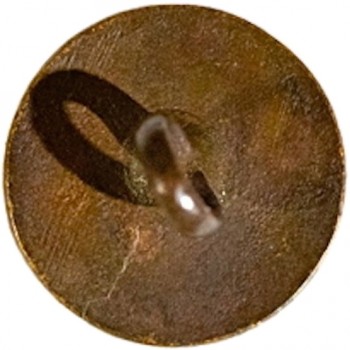
1774-87 ROYAL NAVY OR LATER CONTINENTAL NAVY CUFF BUTTON
Color: A Golden Brown.
Metal: Flat, 1-Piece, Stamped Design, Brass.
Size: 14mm. Cuff / Vest size
Variation: Upright Anchor with a Relaxed Top Ring / Five Raised knobs in Stock Remain.
Present Condition: A Non Excavated Specimen, Exceptional Planchet Casting, Exceptional Impressions Remain.
Robert’s Comments: This probably was a favorite for garment makers who furnished sailors clothes and uniforms. There are several die variants known for this cuff. The button’s pattern depicts a crude style Upright Anchor with a Crude Style V-Shaped Crown. The anchor depicts a Relaxed Top Ring without an attached cable or chain. The anchor’s straight stock depicts Five Raised knobs. The pattern is stamped into a plain flat round planchet with no decorative edge border. Popular button for Rev War Collectors.
Reverse Button Analysis: This is a one-piece button with a loop shank. The shank is original, straight, and intact. No back mark.
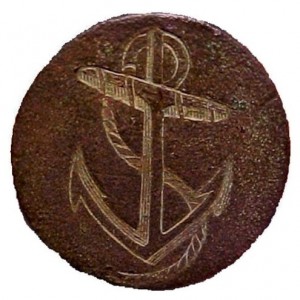
1774-87 ROYAL NAVY OFFICER’S BUTTON
Color: A Rusty Brown with Orange Undertones.
Metal: Flat, 1-Piece, Impressed Design, Gilded Brass.
Size: 21mm. Coat Size
Variation: Fouled Anchor with Decorative Lines and A V-Shaped Crown / Relaxed Top Ring / Slanted Lined Stock.
Present Condition: An Excavated Example, Strong Planchet Casting, Strong Impressions.
Robert’s Comments: This is another pattern associated with British Royal Navy Officers. The button’s pattern depicts a Fouled Anchor with Inner Decorative Lines on Half of the whole depiction. There is a Slender “ V“ Shaped Crown. The cable comes off the anchor’s Relaxed Top Ring on the right hand-side. The cable goes under a Slanted Bottom Lined Stock, then under the shaft and left fluke, and then fish hooks below the crown. The pattern is impressed into a plain flat round brass planchet that has no decorative or raised edge border. This depiction might have been an attempt to give the pattern a Multi-Dementional Look!
Reverse Button Analysis: This is a flat one-piece button with a loop shank.


1774-87 ROYAL NAVY CAPTAIN AND COMMANDER’S BUTTON
Color: A Chocolate Brown with Gold & Green Encrustations.
Metal: Flat, 1-Piece, Impressed Design, Gilt Brass.
Size: 22mm. Coat Size
Variation: Fouled Anchor with a V-Shaped Crown / Horizontal Stock.
Present Condition: An Excavated Specimen, Good/Strong Planchet Casting, Exceptional Impressions.
Robert’s Comments: This was a popular “V” shaped pattern that was frequently used by Royal Navy Officers. The button appears to depict military uniformity with all it’s straight lines. There were a lot of other patterns made this way with just slight variations in the anchors thickness. The button’s pattern depicts an Evenly Spaced Uniformly Lined Fouled Anchor with a V-Shaped Crown. The cable comes off the anchor’s Upright Top Ring on the left hand-side. The cable goes under a Horizontal Stock with Square Ends. The cable then goes over and under the horizontal lined shaft, and under then around the left fluke’s tip which in-turn leads below the crown where it then dips behind right fluke then shoots off the right side. The crown and flukes have a Wide Pointed “V” Shape. The pattern is impressed into a plain flat round brass planchet with no decorative or raised edge border.
Reverse Button Analysis: This is a one-piece button with a copper loop shank? The shank is unfortunately missing. No back mark.
The RJ Silverstein Collection.~
This was Excavated in Boston Massachusetts.
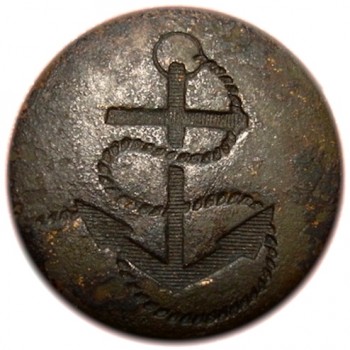
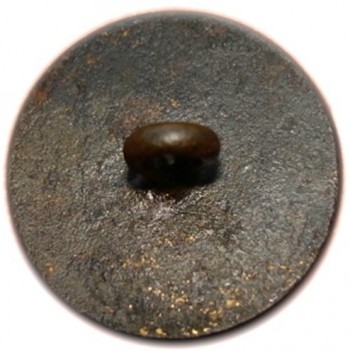
1774-87 ROYAL NAVY CAPTAIN AND COMMANDER’S BUTTON
Color: A Mud Brown.
Metal: Flat, 1-Piece, Impressed Design, Gilt Brass.
Size: 22mm. Coat Size
Variation: Fouled Anchor with a V-Shaped Crown / Horizontal Stock W/ Square Ends / Reverse Cable Lines.
Present Condition: An Excavated Example, Strong Planchet Casting, Exceptional Impressions.
Robert’s Comments: This is a perfect example of a similar die variant that is only slightly different then the specimen pictured above. Even though there are a number of variations to this design, most are extremely close and only differentiate in subtle ways. The button’s pattern depicts a Fouled Anchor with a Pointed “V” Shaped Crown. The cable comes off the anchor’s Upright Top Ring on the left hand-side. The cable goes under an evenly spaced vertically lined horizontal stock. The it goes over and under a horizontally lined shaft, and then under the tip of the left fluke. The cable Fish Hooks below the “V” Shaped Crown and then dips behind the right fluke and shoots off the right hand side. If you notice in this variant from the one above, the cable lines are in opposite directions. The pattern is stamped into a plain flat round brass planchet with no decorative or raised edge border.
Reverse Button Analysis: This is a one-piece button with a loop shank. The shank is original, straight, and intact. No back mark.
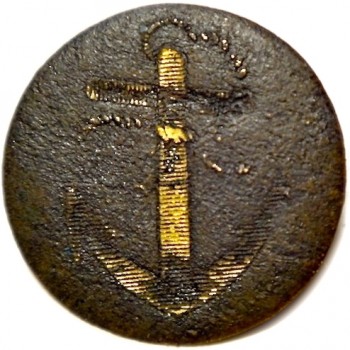

1774-87 ROYAL NAVY CAPTAIN AND COMMANDER’S BUTTON
Color: A Muddy Brown with Gold Design Highlights.
Metal: Flat, 1-Piece, Impressed Design, Gilt Brass.
Size: 22mm. Coat Size
Variation: Upright Anchor with a Barbed Crown / Slanted Lined Stock
Present Condition: An Excavated Example, Good Planchet, Good Impressions.
Robert’s Comments: This is another pattern variation that was used by officers in the Royal Navy. The button’s pattern depicts a Large Upright Anchor with a Slightly Barbed Crown. The pattern shows a cable coming off the anchor’s Upright Top Ring on the left hand side. The cable goes under a Slanted Lined Stock, and then over and under the shaft, and then under the left fluke, and then dangles under the barbed crown. The pattern is impressed into a flat round brass planchet with no raised edge border.
Reverse Button Analysis: This is a one-piece button with a loop shank. The shank is original, straight, and intact. No back mark.
This was Dug in the State of Delaware, near a ship landing site.


1780’s-1815 ROYAL NAVY CAPTAIN AND COMMANDER’S BUTTON
Color: A Light Brown with Coppery Red Undertones.
Metal: 1-Piece, Domed, Impressed Design, Gilded Brass.
Size: 19.59mm. Coat Size
Variation: Upright Fouled Anchor with Decorative Lines / Rope Comes Down Through the Anchor’s Top Ring.
Present Condition: An Excavated Example, Strong Planchet Casting, Strong Impressions.
Robert’s Comments: This specimen is another pattern variation used by Navy Officers in the late 17th and early 19th Century. The button’s pattern depicts an Upright Fouled Anchor with Thin Decorative Lines within. In this unusual pattern, the Rope Comes Down Through the Anchor’s Upright Top Ring on the right hand-side (This is an usual design). The rope goes under a straight decorative lined stock with rounded ends, and then behind the shaft 2x, then under the right fluke, and fish hooks below the Pointed “V” Shaped Crown, and then curls up just under the left fluke pointing toward the shaft. The pattern is impressed into a plain domed round planchet with no decorative or raised edge border.
Reverse Button Analysis: This is a one-piece button with a loop shank in a recessed well. The shank is original, straight, and intact. TREBLE GILT STANDARD. COLOUR rm. within a recessed well.
The RJ Silverstein Collection.~
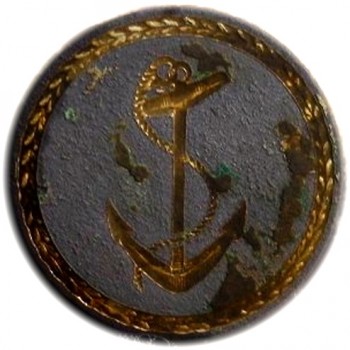
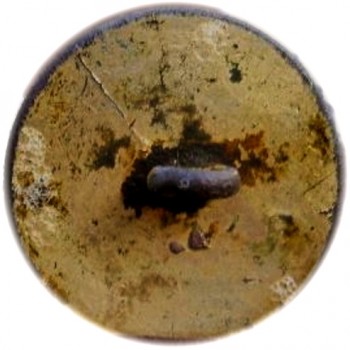
1787 ROYAL NAVY FLAG OFFICER’S BUTTON or EARLIER?
Color: A Ghostly Brown with Gold in the Pattern.
Metal: Flat, 1-Piece, Impressed Design, Gilt Brass.
Size: 20mm. Coat Size
Variation: Upright Anchor with a Skinny Shaft and Roundish Crown / Slanted Stock / Foliated Wreath.
Present Condition: An Excavated Example, Strong Planchet Casting, Strong Impressions.
Robert’s Comments: This is a tough button for me to identify. Has the trade marks of an earlier Rev War Era Button, but the added Wreath is attributed to the later Royal Navy Flag Officers.. ie Admiral’s button of 1787. Another interesting fact is that this was dug by a local treasure hunter on the North Shore of Massachusetts. Meaning this very well could have been used by an American Officer, or lost by a British officer in 1812? At this point all speculation. I have a feeling tail end of Rev War. The button’s pattern depicts a Large Upright Anchor with a Skinny Shaft and a Roundish Crown. The flukes also appears to be small in relation to the size of the crown. The pattern shows a cable coming off the anchors top ring on the right hand side. The cable goes under a Slanted Stock, and then under and over the shaft. The cable then falls under the crown just short of the right fluke, and then dangles below the crown. The slanted stock has Two Sets of Vertical Triple Lines, and the shaft has Horizontal Thin Even Lines, and Crown has Vertical Even Lines. Circling the button’s edge is a Foliated Wreath. The pattern is impressed into a plain flat round planchet with no raised edge border.
Reverse Button Analysis: This is a one-piece button with an Alpha shank. The shank is original, straight, and intact. No back mark.
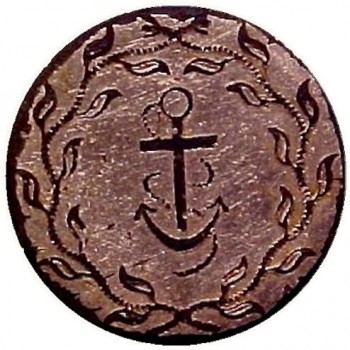

1780’s-1790’s ROYAL MARINES OFFICER’S BUTTON
Color: Silver Ghost.
Metal: Flat, 1-Piece, Impressed Design, Silvered Copper.
Size: 23mm. Coat Size
Variation: Upright Small Anchor and A Roundish Crown / Straight Stock / Foliated Wreath.
Present Condition: An Excavated Example, Strong Planchet Casting, Strong Impressions Remain.
Robert’s Comments: The button’s pattern depicts a Small Upright Anchor with a Crude Shaft, a Roundish Crown, and Small Flukes. The pattern shows a cable coming off the Anchor’s Upright Top Ring on the right hand side. The cable goes under a Straight Stock with Square Ends, and then under the shaft twice. The cable then falls under the crown just short of the left fluke, and then dangles below the crown’s center point. Circling the button’s edge is a Foliated Leaf or Wreath Pattern. The pattern is impressed into a plain flat round copper planchet.
Reverse Button Analysis: This is a one-piece button with an Alpha shank. The shank is original, straight, and intact. No back mark.
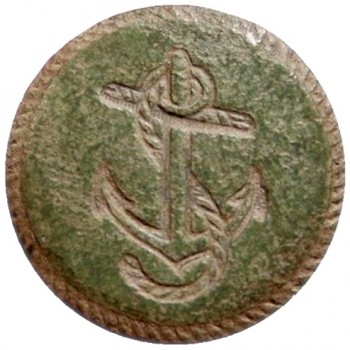
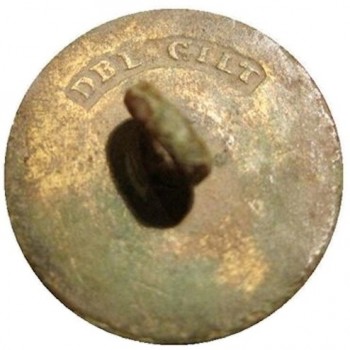
1790-1820’s THE BRITISH MARINES
Color: A Seaweed Green over A Light Brown Undertones.
Metal: Flat,1-Piece, Impressed Design, Double Gilt Brass.
Size: 20mm. Coat Size
Variation: Upright Fouled Anchor with A Barbed Crown / Relaxed Top Ring / Slanted Stock / Cable Edge.
Present Condition: An Excavated Specimen, Strong Planchet Casting, Strong Impressions Remain.
Robert’s Comments: This variant is a little bit more scarce as far as Royal Marine buttons go. The button’s pattern depicts an Upright Fouled Anchor with A Barbed Crown. The rope comes off the anchor’s Relaxed Top Ring on the right hand-side. The rope goes over the Slanted Stock, then under the shaft, and then over the left fluke. It ends in a fish hook under the crown. What makes this button an unusual die variant is that the Anchor has an impressed outline leaving the center with a raised pattern. The pattern is impressed into a plain flat round brass planchet with a Pipe Roped Decorative Edge.
Reverse Button Analysis: This is a flat one-piece button with a loop shank. DBL GILT BRASS rm.
The Bill Cross Collection.~
Dug in South Carolina, The Low Country.
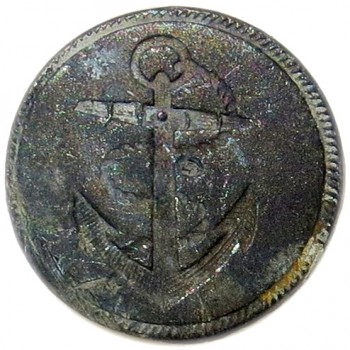

1790-1820’s THE BRITISH MARINES
Color: A White Speckled With A Charcoal Base.
Metal: Flat,1-Piece, Impressed Design, Double Gilt Brass.
Size: 22.75mm. Coat Size
Variation: Upright Fouled Anchor with A Barbed Crown / Slanted Stock / Multi-Directional Lines / Cable Edge.
Present Condition: An Excavated Example, Strong Planchet Casting, Strong Impressions.
Robert’s Comments: This is definitely one of my favorite decorative Marines buttons. This die variant was also used by the British’s Royal Marines for quite awhile. The button’s pattern depicts an Upright Fouled Anchor with A Barbed Crown and Two Large Flukes. The Stock is Slanted with Rounded Ends and depicts Four Lines with a Center Dot. The rope comes off the anchor’s Upright Top Ring on the left hand-side then under the slanted stock and Wide Thick Shaft 3x. It then hangs under the right hand side of the crown. The shaft and stock have vertical lines, and the Crown & Flukes have Multi-Directional Lines. The pattern is impressed into a plain flat round brass planchet and has a lowered Pipe Rope Decorative Edge border.
Reverse Button Analysis: This is a flat one-piece button with a boss and loop shank. NUTTING & SONS. /COVENT.CARDEN./KING’S.St
The RJ. Silverstein Collection~
Dug Around Lake Erie.
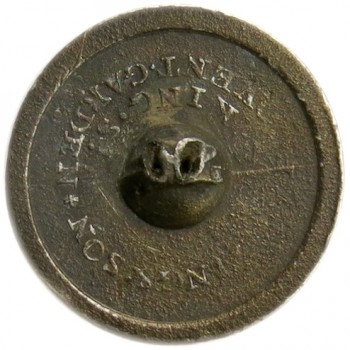
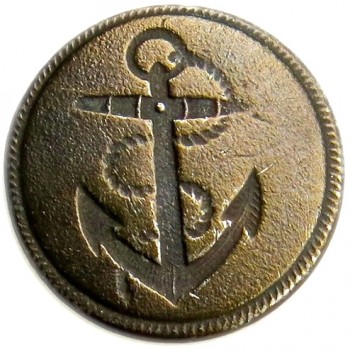
1790-1820’s BRITISH MARINES
Color: A Golden Brown.
Metal: Flat,1-Piece, Impressed Design, Double Gilt Brass.
Size: 22.62mm. Coat Size
Variation: Upright Fouled Anchor with A Barbed Crown / Slanted Stock / Multi-Directional Lines / Cable Edge.
Present Condition: An Excavated Example, Strong Planchet Casting, Strong Impressions.
Robert’s Comments: Because of the condition, I would say this is most likely a water or sandy soil find. This is the same pattern as above, just a clearer detail depiction. The button’s pattern depicts an Upright Fouled Anchor with A Barbed Crown. The rope comes off the anchor’s top ring on the left hand-side. The rope goes under a Slanted Stock with Four Lines and a Center Dot, and then under a Wide Thick Shaft 3x. It then hangs under the right side of the crown below the fluke. The stock has four diagonal lines and a center dot. The wide shaft has vertical lines, and the crown & flukes have Multi-Directional Lines decorated within. The pattern is impressed into a plain flat round brass planchet that has a Pipe Rope Decorative Edge.
Reverse Button Analysis: This is a flat one-piece button with a boss and loop shank. The loop is broken off as most specimens found. NUTTING & SONS. / COVENT.CARDEN./KING’S.St
The RJ. Silverstein Collection.~
Dug Around Lake Ontario.
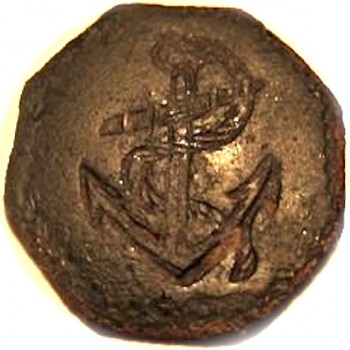
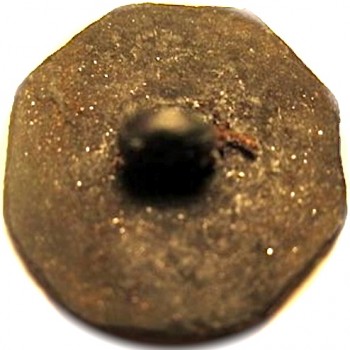
1774-87 BRITISH MARINES OFFICER’S CUFF BUTTON
Color: A Coppery Brown.
Metal: Flat, 1-Piece, Impressed Design, Gilt Brass.
Size: 17mm. Cuff Size
Variation: Upright Fouled Anchor / V-Shaped Crown / Thick Cable / Hexagonal Shape / Decorative Pipe Rope Edge.
Present Condition: An Excavated Example, Good Planchet Casting, Good Impressions Remain.
Robert’s Comments: This is another variation of a fouled anchor and cable edge pattern that happen to be dug right here in upstate New York. We previously demonstrated that the Hexagonal Shape was first seen with Royal Navy buttons as early as 1748 with specimens depicting the Tudor Rose. The button’s decorative Cable Edge in this era was attributed to the British Marines instead of the Royal Navy who always used a plain edge. The button’s pattern depicts a Fouled Upright Anchor with a Crude V-Shaped Crown. There is a Thick Cable that comes off the anchor’s Upright Top Ring on the left hand side. The cable goes under a Straight Lined Stock, then goes over and under the shaft, and then under the left fluke. The cable ends dangling below the crown. The button has a Hexagonal Shape with a Decorative Cable Edge. The pattern is impressed into a brass planchet.
Reverse Button Analysis: This is a One-Piece Casting for the Reverse Shank. The shank is original, straight and intact. The surface appears course, and has a granular texture.
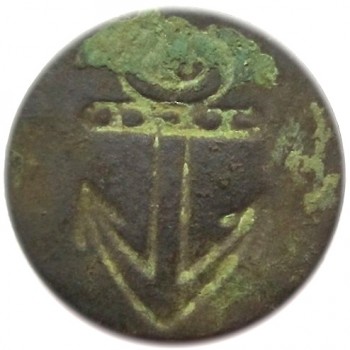

1774-87 ROYAL NAVY OR LATE CONTINENTAL NAVY CUFF BUTTON
Color: A Dark Brown with Florescent Green Encrustations.
Metal: Flat, 1-Piece Stamped Design, Brass.
Size: 13.54mm. Cuff / Vest Size
Variation: Upright Anchor with a Relaxed Top Ring / Five Raised knobs in Stock.
Present Condition: An Excavated Specimen, Good Planchet Casting, Strong Impressions Remain.
Robert’s Comments: This probably was a favorite for garment makers who furnished sailors clothes and uniforms. There are several die variants known for this cuff. The button’s pattern depicts a crude style Upright Anchor with a Crude Style V-Shaped Crown. The anchor depicts a Relaxed Top Ring without an attached cable or chain. The anchor’s straight stock depicts Five Raised knobs. The pattern is stamped into a plain flat round planchet with no decorative edge border. Popular button for Rev War Collectors.
Reverse Button Analysis: This is a one-piece button with a loop shank. The shank is original, straight, and intact. No back mark.
The RJ Silverstein Collection.~
This was Excavated in Water at Fort Erie.~
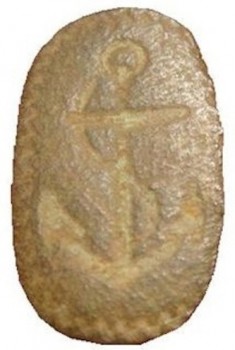
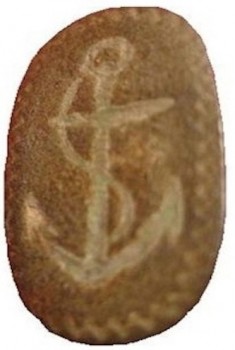
1770-90 ROYAL NAVY CAPTAIN OR COMMANDERS OVAL CUFF BUTTON
Color: A Coppery Brown Shade.
Metal: Flat, Oval, 1-Piece Stamped Design, Gilt Brass.
Size: 16mm x?. Cuff Size
Variation: Upright Fouled Anchor with a Barbed Crown / Short Cable / Disappears Under the Shaft / Squiggly Line Decorative Border.
Present Condition: An Excavated Example, Good Planchet Casting, Good Impressions.
Robert’s Comments: This shape button is a bit more scarce then the usual round cuff examples. The button’s pattern depicts an Upright Fouled Anchor with a Barbed Crown. There is a Short Cable that comes off the anchor’s top ring on the right hand-side. The cable goes under a straight stock, and then Disappears Under the Shaft. The impressed pattern is set on a plain flat field with a Squiggly Line Decorative Border.
Reverse Button Analysis: This is a one-piece button with a loop shank. The shank is original, straight, and intact. No back mark.
The Bill Cross Collection.~


1780-90 ROYAL NAVY OVAL CUFF BUTTON
Color: A Greenish-Brown With Orange.
Metal: Flat, Oval, 1-Piece Stamped Design, Gilt Brass.
Size: 16mm x. Cuff Size
Variation: Upright Fouled Anchor / Short Cable / Disappears Under theFluke / Oval Decorative Border.
Present Condition: An Excavated Specimen, Good Planchet Casting, Good Impressions Remain.
Robert’s Comments: This is another post-colonial cuff example that was most likely used by an officer in the Royal Navy. The button’s pattern depicts an Upright Fouled Anchor with a Rounded “V” Shaped Crown. There is a Short Lined Cable that comes off the anchor’s top ring on the left hand side. The cable goes under a Slightly Bowed Stock, and then Under the Shaft where it disappears behind the right fluke. The impressed pattern is set on a plain flat field with an unusual Raised Oval Decorative Border.
Reverse Button Analysis: This is a one-piece button with a loop shank. The shank is original, straight, and intact. No back mark.


1770-1820 HER MAJESTY’S COAST GUARD
Color: A Coppery Brown with Beige and Orange Specs.
Metal: Flat, 1-Piece, Raised Design, Copper.
Size: 18.61mm. Cuff Size
Variation: Small Upright Anchor / Royal Garter / Surmounted by a Crown /
Present Condition: An Excavated Specimen, Strong Planchet Casting, Strong High Relief Pattern Remains.
Robert’s Comments: I found this button very difficult to accurately date. Several Royal Navy Button web sites conflict with the original issue date and use. Historically speaking, most Crowns were not added to the Royal Navy’s buttons until the official regulation of 1812; but this is Her Majesty’s Coast Guard, which at the time was under a completely different jurisdiction then the Royal Navy Department. After some more historical research, I found out that Her Majesty’s Coast Guard O/Rs aided the Royal Navy in a “non official capacity” during the American Revolution. In what capacity, one could only theorize. If this button’s crown pattern holds to the 1770’s issue date, this would be the earliest use of a Crown motif adapted by any kind of Navy Button prior to the official regulation of 1812. This button is one of the better preserved specimens a collector could find. Most examples are in deteriorated condition. The button’s pattern depicts a Small Upright Anchor in the center of a Royal Garter which is Surmounted by a Crown. Within the band of the garter the military designation, “COAST” on the left, and “GUARD” on the right side. In the top of the band is the bottom of a Large Crown, and in the bottom of the band is a Buckle The high relief pattern is set on an evenly lined field with a small beveled edge. Being that the pattern is raised instead of impressed, might be a clue to this buttons manufacture date to after 1787.
Reverse Button Analysis: This is a one-piece button with a loop shank. The shank is original, and intact, but bent over.
The RJ Silverstein Collection.~
Excavated on the coast of Florida.~
Royal Navy’s Captain & Commander’s Buttons 1787-1800’s
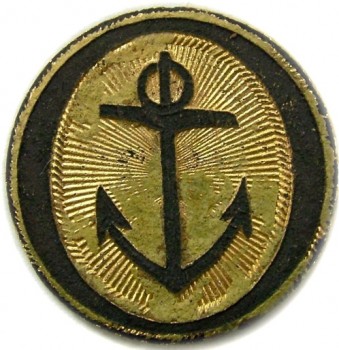
1787-1795 Royal Navy Captain & Commander’s Gilt Buttons
In 1787, the Royal Navy changed their regulations from a flat Gilt button with an impressed anchor pattern to a stylish raised anchor motif within a recessed oval. The former Captain’s pattern of 1774, was then adopted in 1787, for midshipmen. As for Warrant Officers, they weren’t ordered to wear uniforms prior 1787, so they didn’t have an official button style change prior to then. The common sailor or seaman was not issued a standard uniform with regulation buttons, but most crews was provided with a blue jacket that was trimmed with metal, cloth covered, pressed horn, or leather buttons. The term Bluejacket was actually used as a common metaphor to describe British sailors. Sometimes at a Captain’s whim, the buttons would have a pressed anchor motif on them, but this was usually rare. Another important fact worth mentioning is that anchor buttons used by the Royal Navy weren’t exclusive, they were used by merchant seaman as well.
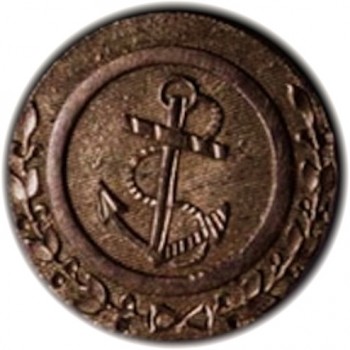
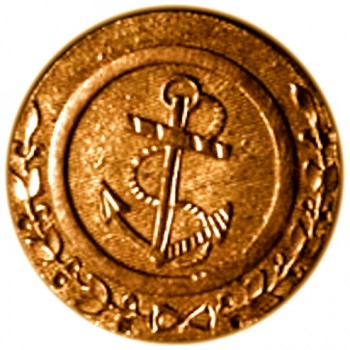
1771-1780 ROYAL NAVY FLAG OFFICER ADMIRAL’S BUTTON
Color: An Orangey-Brown.
Metal: Flat, 1-Piece, Raised Design, Gilt Brass.
Size: 25mm. Coat Size
Variation: Fouled Anchor with a Slanted Stock / Barbed Crown / Round Inner Ring Picture Frame Border /Decorative Wreath.
Present Condition: A Non Excavated Specimen, Strong Planchet Casting, Strong High Relief Pattern Remains.
Robert’s Comments: This button came from the coat worn by Admiral Horatio Nelson during the battle of the Nile on August 1, 1798. The makers mark dates this from 1771 to 1780. Firmin made uniforms for Lord Nelson during the later part of the 18th Century, several of these are on display in the National Maritime Museum in Greenwich London. They are finished with the “Flag Officers button” that was used on Admirals uniforms at the time. There are three die variants known for this button. There could possibly be more, but most likely a limited issue with few made. The differences are noted in the size of the inner ring and the depiction of the wreath and anchor. The buttons pattern depicts a Fouled Anchor with a Slanted Stock and a Barbed Crown. The stock has four diagonal cut lines, and the cable and left fluke has several cut lines. Coming off the anchor’s top ring on the left hand side is a cable. The cable then goes under the slanted stock, shaft and left fluke. The cable then dangles just below the crown pointing toward the barb. The anchor appears to be set on an evenly lined field that is within a raised Round Inner Ring Picture Frame Border. In a semi-circle 3/4 of the way around the buttons edge is a Decorative Wreath. This wreath was used to distinguish the Flag Officer’s rank.
Reverse Button Analysis: This is a one-piece button with an alpha shank. The shank is original, straight, and intact. * Firmin & Sons * Made in England within a double raised ring backmark
*Robert’s Notes: RN Flag Officers with a Vertical Stock within a Wreath Dates to 1771-1812
Nelson’s early career in the Royal Navy. Nelson became a midshipman aboard the Raisonnable in March of 1771 and by 1779 was a post captain in command of the frigate Hinchinbroke.
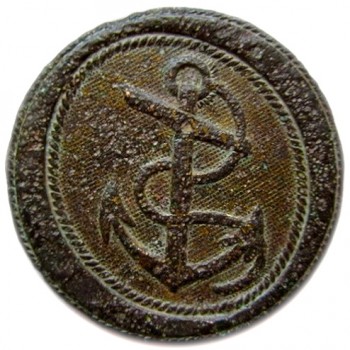

1787-95 ROYAL NAVY CAPTAIN / AMERICAN CAPTAIN & LIEUTENANT’S SLANTED ANCHOR BUTTON
Color: A Brassy Brown with Gold Undertones.
Metal: Flat, 1-Piece, Raised Design, Gilt Brass.
Size: 29.86mm x 30mm.
Variation: Large Fouled Anchor / Barbed Crown / Stippled Field / Oval Picture Frame Border / Thin Decorative Rope Trim.
Present Condition: An Excavated Specimen, Good Planchet Casting, Strong High Relief Pattern Remains.
Robert’s Comments: The Slanted Anchor pattern was officially adopted by the Captains & Commanders of the Royal Navy by 1787. Even though the pattern is English, the evenly lined background was most likely used by American Navy and Marine Captains. Most likely American made using English Designs. There are a few noted anchor depiction variations by different manufacturers, but all are slanted set within a picture frame oval. This button’s pattern depicts a Large Fouled Anchor with a Barbed Crown. There is a cable coming off the anchor’s top ring on the left hand-side. The cable goes under a Slanted Stock, and then under and over the shaft. The cable then goes under the left fluke, and ends in a small fish hook underneath pointing toward the crown. The high relief pattern is set on a Stippled Field that is set within a Sideways Oval Picture Frame Border. There is a Thin Decorative Rope Trim on the inside and outside edge of the oval picture frame border. The high relief pattern is set on a Stippled field, with a large flat slanted oval border that has a thin roped edge. When this pattern was issued, the Lieutenants would start to use the same pattern as the captains.
Reverse Button Analysis: This is a one-piece button with a loop shank. The shank is original, straight and intact. No back mark.
The RJ Silverstein Collection.~
Excavated on land at Fort Erie.
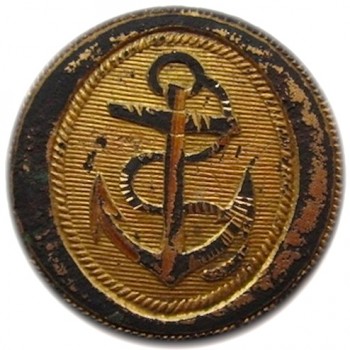
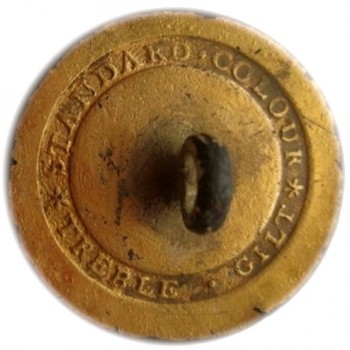
1795-1812 COMMISSIONED OFFICERS
Color: A Golden Brown Mix.
Metal: Flat, 1-Piece, Raised Design, Gilded Brass.
Size: 22.99mm x 23.04mm.
Variation: Large Fouled Upright Anchor / Barbed Crown / Lined Field / Oval Picture Frame Border / Thin Decorative Rope.
Present Condition: An Excavated Specimen, Good Planchet Casting, Strong High Relief Pattern Remains.
Robert’s Comments: This Vertical Upright Anchor pattern quickly replaced the Slanted Anchor pattern in 1795. We know a number of different manufacturers made this pattern with sight variations in the depiction of the anchor. The old pattern was probably still used for a short time on their existing uniforms, but this new pattern would have been on their new uniforms. The button’s pattern depicts a Large Fouled Upright Anchor with a Barbed Crown. There is a cable coming off the anchor’s Upright Top Ring on the left hand-side. The cable goes over a slightly slanted stock and under the shaft 2x; then goes under the left fluke and ends in a small fish hook underneath the the crown. The anchor has crude cut lines in the stock, cable and left fluke. The shaft has long vertical lines. The high relief pattern is set on an Evenly Lined Field that is set within an Oval Picture Frame Border. There is a Thin Decorative Rope Trim on the inside and outside edge of the oval picture frame border.
Reverse Button Analysis: This is a one-piece button with a loop shank. The shank is original, straight and intact. STANDARD. COLOUR*TREBLE. GILT
The RJ Silverstein Collection.~
Excavated on Land around Fort Erie.~
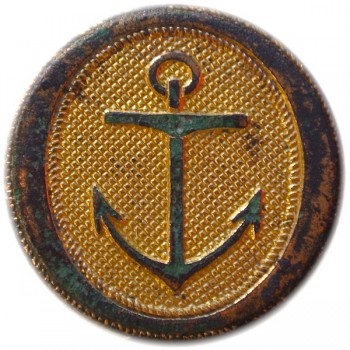
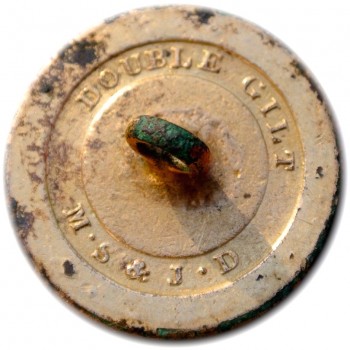
1795-1795 ROYAL NAVY COMMISSIONED OFFICERS.
Color: An Orange-Gold Over Brass Yellow.
Metal: Flat, 1-Piece, Raised Design, Gilt Brass.
Size: 22mm. Coat Size
Variation: Stipple Field Behind Anchor.
Albert’s: BNH 6-A
Tice:
Variation: Large Slightly Barbed Anchor / Upright Top Ring / Stipple Field / Oval Frame Border / Pipe Rope Trim.
Present Condition: An Excavated Specimen, Strong Planchet Casting, Strong High Relief Pattern Remains.
Robert’s Comments: This Commissioned Officer’s button depicts a stylish Anchor onto of a rare stipple background. The pattern has two backmarks. Treble Gilt and Double Gilt rm in a Channel. Albert’s lists this on page 90 as a Commissioned Officers Post Rev War pattern from 1787 to 1795. The button most likely was used by the Royal Navy officers who sailed around Europe and Asia. No buttons with this pattern were ever found in the US. The button’s pattern depicts a Large Slightly Barbed Anchor with an Upright Top Ring. The anchor is depicted on a Stipple Field that is set within an Oval Picture Frame Border. There is a Thin Decorative Rope Trim on the inside and outside edge of the picture frame border.
Reverse Button Analysis: This is a flat one-piece button with a loop shank. The shank is original, straight and intact. Double Gilt / M.S & J. D RM in a ChanneL.


1795-1812 COMMISSIONED OFFICERS & LATER ROYAL NAVY SURGEON
Color: A Yellow Gold Over Charcoal.
Metal: Flat, 1-Piece, Raised Design, Gilt Brass.
Size: 21.89mm. Coat Size
Variation: Rayed Field Behind Anchor.
Albert’s: BNH 6
Tice: Back mark PG 154
Variation: Large Slightly Barbed Anchor / Relaxed Top Ring / Rayed Field / Oval Frame Border / Pipe Rope Trim.
Present Condition: An Excavated Specimen, Strong Planchet Casting, Strong High Relief Pattern Remains.
Robert’s Comments: After this issue, all Physicians and Surgeons will use the same style pattern as Captains and Commanders. This stylish rayed pattern was made by a number of different manufacturers for about 25 years. There are a few different die variants known with subtle differences in anchors styles. Albert’s lists this on page 90 as a Commissioned Officers pattern from 1787 to 1795. Tice’s back mark book lists this as 1790 to 1820 on page 154. Three English Navy Button sites lists this as 1805-12 Royal Navy Surgeon’s button, or an early 1790’s Captain’s button. The button’s pattern depicts a Large Slightly Barbed Anchor with a Relaxed Top Ring. The anchor is depicted on a Rayed Field that is set within an Oval Picture Frame Border. There is a Thin Decorative Rope Trim on the inside and outside edge of the picture frame border.
Reverse Button Analysis: This is a flat one-piece button with a loop shank. The shank is original, straight and intact. TURNER & DICKINSON HAMMOND . rmdc (HamondTurnerDickenson01)
The RJ Silverstein Collection.~
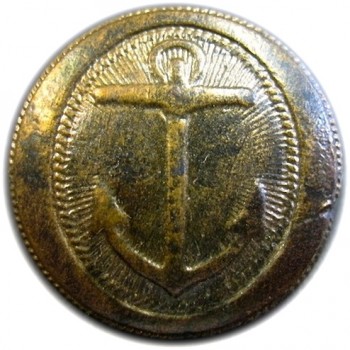
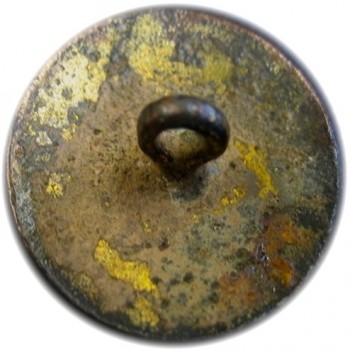
1787-95 ROYAL NAVY COMMISSIONED OFFICERS
Color: A Golden Azure.
Metal: Slightly Convex, 1-Piece, Raised Design, Gilt Brass.
Size: 23mm. Coat Size
Variation: A Barbed Anchor / Rayed Field / Thin Decorative Rope Trim / Anchor’s Shaft goes Halfway Through the Top Ring.
Present Condition: An Excavated Example, Strong Planchet Casting, Strong High Relief Pattern.
Robert’s Comments: This stylish rayed pattern was made by a number manufacturers for about 25 years. There are a few die variants known that that show a slight difference in anchor styles. This button’s pattern depicts A Barbed Anchor with a Upright Top Ring. In this variant, the Anchor’s Shaft goes Halfway Through the Upright Top Ring. The anchor is depicted on a Rayed Field that is set within an oval picture frame border. There is a Thin Decorative Rope Trim on the inside and outside edge of the picture frame border.
Reverse Button Analysis: This is a concave one-piece button with a loop shank. The shank is original, straight and intact.
A Water Find near Kingston, Ontario
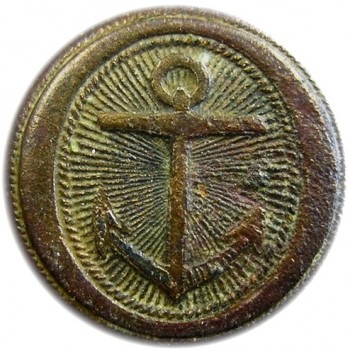
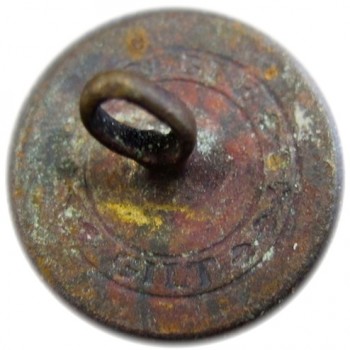
1795-1805 ROYAL NAVY CAPTAINS & COMMANDERS CUFF
1805-1812 ROYAL NAVY SURGEON
Color: A Golden Brown Mix.
Metal: Flat, 1-Piece, Raised Design, Gilt Brass.
Size: 17mm. Cuff Size
Variation: Large Slightly Barbed Anchor / Relaxed Top Ring / Rayed Field / Oval Picture Frame Border / Thin Rope Trim.
Present Condition: An Excavated Example, Strong Planchet Casting, Strong High Relief Pattern.
Robert’s Comments: This stylish rayed pattern was made by a number manufacturers for about 25 years. There are a few die variants known that that show a slight difference in anchor styles. This button’s pattern depicts A Barbed Anchor with a Upright Top Ring. The anchor is depicted on a Rayed Field that is set within an Oval Picture Frame Border. There is a Thin Decorative Pipe Rope Trim on the inside and outside edge of the picture frame border.
Reverse Button Analysis: This is a one-piece button with a loop shank. The shank is original, straight and intact. TREBLE GILT.
A Water Find near Kingston, Ontario
1807-25 ROYAL NAVY SENIOR GUNNER’S BUTTON
1810-25 NAPOLEONIC COASTAL ARTILLERY BUTTON
Color: Charcoal highlights on a Gold Background.
Metal: Flat, 1-Piece, Raised Design, Gilt Brass.
Size: 22mm. Coat Size.
Variation: Large Slightly Barbed Anchor / Cannon on a Platform / Evenly Lined Field / Oval Picture Frame Border / Thin Rope Trim.
Present Condition: An Excavated Example, Good Planchet Casting, Strong High Relief Pattern.
Robert’s Comments: This button’s motif appears to be a collector’s favorite. Made by Turner & Dickinson & Hammond in the beginning of the 19th Century in both a coat and matching cuff. This button’s pattern depicts a Large Slightly Barbed Anchor with a Upright Top Ring. There is a Relaxed Cable coming off the left hand side of the top ring, and then goes behind the shaft 2x and then behind the L-H-S of the crown where it dangles below. Flanking each side of the anchor is a Cannon on a Platform that points inward toward the shaft. The high relief pattern is set within an Oval Picture Frame Border. There is a Thin Decorative Pipe Rope Trim on the inside and outside edge of the picture frame border.
Reverse Button Analysis: This is a one-piece button with a loop shank. The shank is original, straight and intact. TURNER & DICKINSON * HAMMOND.
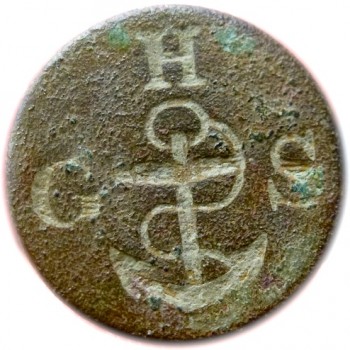
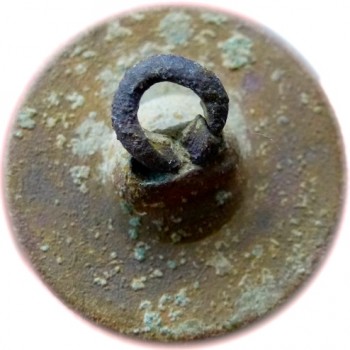
1807-12 ROYAL NAVY’S GREENWICH HOSPITAL SERVICE
Color: A Rusty Brown W/ White Encrustations.
Metal: Flat, 1-Piece, Raised Design, Gilt?
Size: 16mm.
Rarity: R-3
Present Condition: An Excavated Specimen, Good Planchet Condition, Good High Relief Pattern Remains.
Variation: Small Fouled Anchor / Upright Top Ring / Initials C H S
Robert’s Comments: This button’s pattern depicts A Small Fouled Anchor with an Upright Top Ring. The rope comes off the anchor’s upright ring on the left hand-side. The rope goes over the stock and then under the anchor’s shaft 2x. It ends in a J-Hook facing right under the Crown. The initials, “C H S” for Greenwich Hospital Service is in the compass direction E, N, W. The impressed pattern is set on a plain flat field with no edge border.
Reverse Button Analysis: This is a one-piece button with a loop shank. The shank is unfortunately bent, but is original and intact.
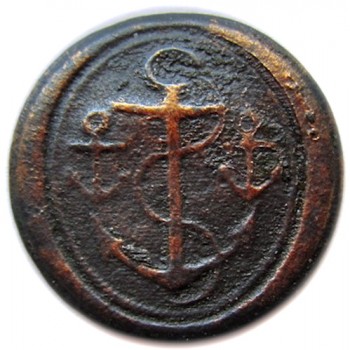
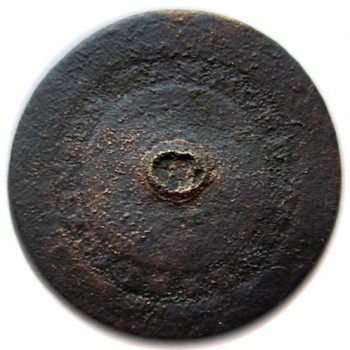
1805-07 ROYAL NAVY MASTER’S BUTTON
Color: A Two Tone Shoe Polish Brown.
Metal: Flat, 1-Piece, Raised Design, Gilt Brass.
Size: 21.64mm.
Variation: Upright Fouled Anchor / Barbed Crown / Cable Dangling / Small Upright Anchor / Lined Field / Oval Picture Frame
Present Condition: An Excavated Specimen, Good Planchet Casting, Good/Strong High Relief Pattern Remains.
Robert’s Comments: This is a Royal Navy Masters button that was briefly used from 1805-07. This short lived button only had two die variants I know of. The button’s pattern depicts a Large Upright Fouled Anchor with a Barbed Crown. In this pattern, there is a Cable Dangling off the Center anchor’s upright top ring on the left hand-side. This goes under a horizontal stock and then wraps under the shaft 2x. The cable then goes under the left fluke, and ends in a fish hook under the crown’s barb. Flanking each side of the center anchor is a Small Upright Anchor. The anchor is depicted on a Lined Field that is set within an Oval Picture Frame Border. There is a Thin Decorative Rope Trim on the inside and outside edge of the picture frame border.
Reverse Button Analysis: This is a one-piece button with a loop shank. The shank is unfortunately missing. TURNER & DICKINSON HAMMOND . rmdc
The RJ Silverstein Collection.~
Excavated in the Water at Fort Erie.
Collectors should note, this pattern was replaced with a new pattern which “did not have a Cable coming off the center anchor’s top ring.” The 1807-25 pattern was used by the Master, Assistant Master and also the Royal Navy Vol. GR from 1824-25.
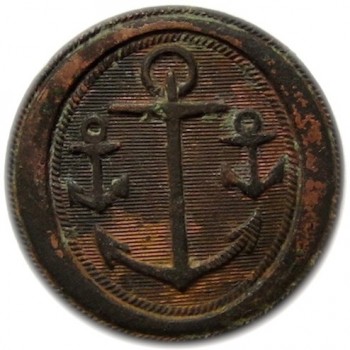
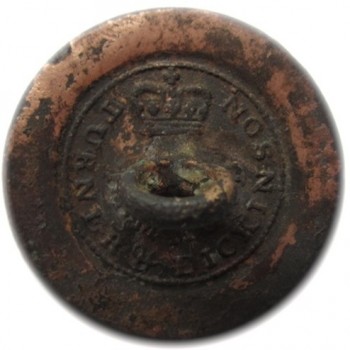
1807-25 ROYAL NAVY MASTER’S & ASSIST. MASTERS BUTTON
Color: A Two Tone Shoe Polish Brown.
Metal: Flat, 1-Piece, Raised Design, Gilt Brass.
Size: 22.64mm.
Variation: Large Skinny Shaft Upright Anchor / Barbed Crown / Small Upright Anchor / Lined Field / Oval Picture Frame Border
Present Condition: An Excavated Specimen, Good Planchet Casting, Strong High Relief Pattern Remains.
Robert’s Comments: This pattern quickly replaced the original Master’s button, and was adopted by the Assistant Master, and RN Vol. GR as well. We also know there were a few die variants made by several manufacturers. Most patterns only differentiated by the depiction of the anchors. The button’s pattern depicts a Large Skinny Shaft Upright Anchor with a Barbed Crown. Flanking each side of the center anchor is a Small Upright Anchor. All three anchors depict horizontal stocks. Only the large center anchor has a lined fluke on the left. The anchor is depicted on a Lined Field that is set within an Oval Picture Frame Border. There is a Thin Decorative Rope Trim on the inside and outside edge of the picture frame border.
Reverse Button Analysis: This is a one-piece button with a loop shank. The shank is original, straight, and intact. TURNER & DICKINSON Crown Motif.
The RJ Silverstein Collection.~
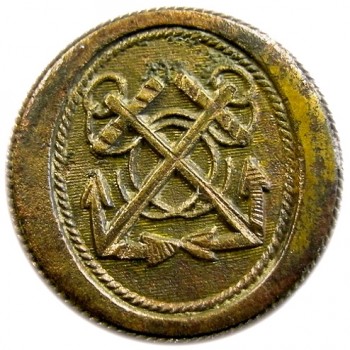
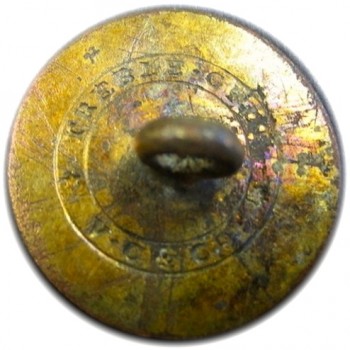
1807-12 ROYAL NAVY PURSER’S BUTTON
Color: A Gilded Coppery Brown.
Metal: Flat, 1-Piece, Raised Design, Gilt Copper.
Size: 23mm.
Present Condition: An Excavated Specimen, Strong Planchet Casting, Strong High Relief Pattern.
Variation: Two Slanted Fouled Anchors / Cross in the Center / Cable / Raised Round Picture Frame Edge Border.
Robert’s Comments: This is one of the harder officer’s patterns to find in good condition. This button’s pattern depicts Two Slanted Fouled Anchors that Cross in the Center. Both anchors depict a Cable coming off the anchor’s top ring on the right hand-side. Each cable go around their anchor’s stock, and then under the shafts 2x. Both cables then dangle below their anchor’s left fluke. The high relief pattern is set on a lined field with aRaised Round Picture Frame Edge Border.
Reverse Button Analysis: This is a one-piece button with a loop shank. The shank is unfortunately bent, but is original and intact.
Found by Kingston, Ontario.~
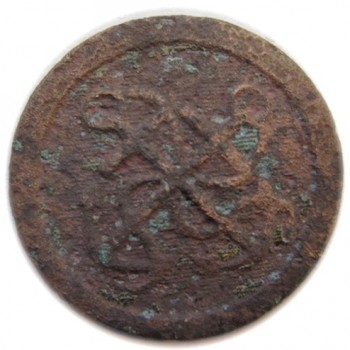
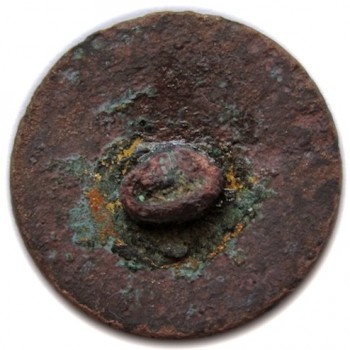
1807-12 ROYAL NAVY PURSER’S BUTTON
Color: A Rusty Brown.
Metal: Flat, 1-Piece, Raised Design, Gilt Copper.
Size: 22.05mm.
Rarity: R-5
Present Condition: An Excavated Specimen, Good Planchet Casting, Good High Relief Pattern Remains.
Variation: Two Slanted Fouled Anchors / Cross in the Center / Cable / Raised Round Picture Frame Edge Border.
Robert’s Comments: This button’s pattern depicts Two Slanted Fouled Anchors that Cross in the Center. Both anchors depict a Cable coming off the anchor’s upright top rings on the right hand-side. Each cable go around their anchor’s stock, and then under the shafts 2x. Both cables then dangle below their anchor’s left fluke. The high relief pattern is set on a lined field with a Raised Round Picture Frame edge border.
Reverse Button Analysis: This is a one-piece button with a loop shank. The shank is unfortunately bent, but is original and intact.
The RJ Silverstein Collection.~
Excavated in the Water at Fort Erie.~
This pattern was later replaced in 1812 with a variant that depicted a crown above the cross-hatch.
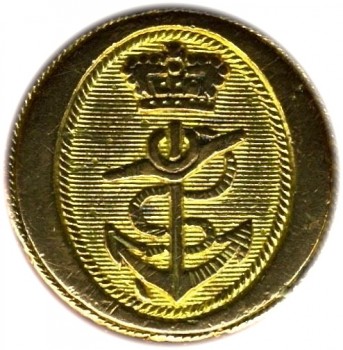

1812-15 ROYAL NAVY CAPTAIN & COMMANDER’S COAT BUTTON
Color: A Bright Gold.
Metal: Flat, 1-Piece, Raised Design, Gilt Brass.
Size: 21mm. Coat Size
Variation: Medium Fouled Anchor / Slightly Barbed Crown / Crown / Oval Picture Frame Border / Thin Decorative Rope.
Present Condition: A Non Excavated Specimen, Good Planchet Condition, A Strong High Relief Pattern Remains.
Robert’s Comments: This gilt button was most likely made for a Navy officer to wear on his dress uniform. The button’s pattern depicts a Small Ornate Crown surmounting a raised anchor. The crown appears to have a raised stipple dot outline with several impressed stipples within. There is a Large Anchor depicted with a Slanted Stock and a Slightly Barbed Crown. The anchor has crude cut lines in both flukes and the raised cable. The rope / cable comes off the Relaxed Top Ring on the left-hand-side and then goes downward under the stock, shaft, and crown. The high relief pattern is set on an Evenly Lined Field that is set within an Oval Picture Frame with a thin inside decorative Cable Border. The outside edge of the button also has a Pipe Rope decorative border.
Reverse Button Analysis: This is a one-piece button with a loop shank. The shank is original, straight and intact. Raised Stipple Ring. s. Meredith . Gilt
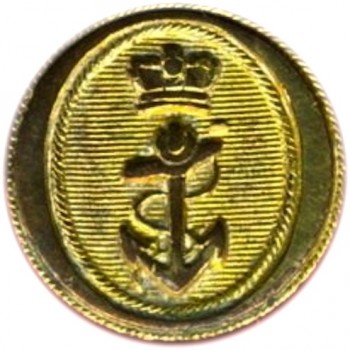
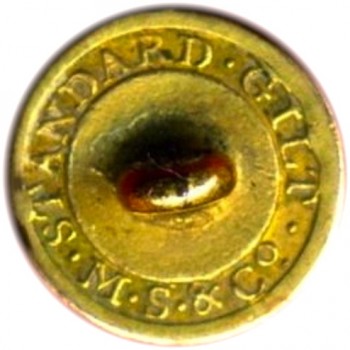
1812-15 ROYAL NAVY CAPTAIN & COMMANDER’S CUFF BUTTON
Color: A Bright Gold.
Metal: Flat, 1-Piece, Raised Design, Gilt Brass.
Size: 15mm. Cuff Size
Variation: Small Fouled Anchor / Small Plain Crown / Oval Picture Frame Border / Thin Decorative Pipe Rope Edge.
Present Condition: A Non Excavated Specimen, Good Planchet Condition, A Strong High Relief Pattern Remains.
Robert’s Comments: This gilt cuff button was most likely made for an officer’s dress uniform. The button’s pattern depicts a Small Plain Crown surmounting a raised anchor. There is a Small Plain Anchor depicted with a Slanted Stock and a V-Shaped Crown. The rope / cable comes off the Relaxed Top Ring on the left-hand-side and then goes downward under the stock, shaft, and crown. The high relief pattern is set on an Evenly Lined Field that is set within an Oval Picture Frame with a thin inside Decorative Cable Border. The outside edge of the button also has a Pipe Rope decorative border.
Reverse Button Analysis: This is a one-piece button with a loop shank. The shank is original, straight and intact. RM STANDARD . GILT / M.S. & CO.


